Joshua Farrell-Molloy
From blood and soil to ecogram
A thematic analysis of eco-fascist subculture on Telegram
1. Introduction: The renewed relevance of Eco-fascism
2.1. Defining and understanding Eco-fascism
2.2. Eco-fascism online: existing work
Prominent figures associated with eco-fascism
3.1. Aims and justification of methodology and case study
3.4. Ethics and research safety considerations
4.1. Outlining eco-fascism: nature, outgroups/ingroups and militancy

GUID: 2571784F
Trento ID: 225124
CU ID: 93557873
Presented in partial fulfilment of the requirements for the Degree of International Master in Security, Intelligence and Strategic Studies
Word Count: 21987
Supervisor: Dr.Vit Stritecky
Date of Submission: August 10th 2022

Front Matter
Acknowledgements
Thanks to Allison, my parents and all those who have supported me.
List of Figures
Figure 1. Bucolic landscape in France
Figure 2. Isolated cabin in nature
Figure 3.Tree depicting ‘human eyes’
Figure 4.“Nature is my Church”
Figure 5. Algiz rune
Figure 6. Sonnenrad as a rising sun
Figure 7. Sonnenrad moon
Figure 8. ‘Nature as
Figure 9. “Protect nature”
Figure 10. Antisemitic violence
Figure 11. Christina Spicuzza
Figure 12. Siege-culture edited ‘Smokey Bear’ mascot
Figure 13. Burning substation
Figure 14. ‘Saint’ McVeigh
Figure 15. Terrorwave
Figure 16. Siege IRA
Figure 17. Kaczynski “Defend The Wild”
Figure 18. Kaczynski in Siege-culture skull mask
Figure 19. Kaczynski quotes
Figure 20. “Saint Ted”
Figure 21. Kaczynski: “I speak for the trees”
Figure 22. Smashed computer
Figure 23. “Stay forever”
Figure 24. “Return to Nature and Beauty”
Figure 25. SS flag alongside harvest of chicken eggs
Figure 26.“Reject the concrete jungle, come home to nature and beauty”
Figure 27.“Goin back to a simple life […]”
Figure 28. Cottagecore male gaze
Figure 29. Tradwife
Figure 30. Ancient warrior
Figure 31. Zeus: “All men should be dangerous"
Figure 32. Lyndon McLeod
Figure 33. ‘Great Reset’
Figure 34. Raw Milk
Figure 35. Pure raw masculinity
Figure 36. Folk art illustrations
Figure 37. Woman wearing deer antlers
Figure 38. Gnomecore
Figure 39. "Make Europe Pagan Again"
Figure 40. Utopian eco-fascist imaginary.
1. Introduction: The renewed relevance of Eco-fascism
Climate change is here, and its effects are already being felt across the world. The future looks bleak, with extreme weather events, rising sea levels, increased global instability, crop failures, water scarcity and the risk of millions of climate migrants, all of which has the potential to exacerbate another growing problem: the rise in far-right extremism.
In this context, the concept of eco-fascism has become the focus of renewed attention in both scholarly work as well as mainstream media coverage, spurred on by two developments. First, an emergence of online far-right communities expressing environmental views. Secondly, three high-profile terrorist attacks carried out by individuals declaring themselves as eco-fascist.
In March of 2019, in Christchurch, New Zealand, White supremacist Brenton Tarrant murdered 51 Muslim worshippers during a livestreamed shooting attack at two mosques. In his manifesto, ‘The Great Replacement’, Tarrant showed his obsession with birth-rates and demography, as he claimed that immigration was functioning as a form of “environmental warfare” (Darby, 2019) endangering white ethnic autonomy. Tarrant further expressed that he wished to “ensure the existence of our people and a future for white children, whilst preserving and exulting nature and the natural order” (Campion, 2021), declaring there was “no nationalism without environmentalism” (Darby, 2019).
Nearly five months later in the US, Patrick Crusius, who claimed to have been directly inspired by Tarrant, killed 22 people during a shooting attack targeting Latinos at a Walmart in El Paso, Texas. In his manifesto, ‘An Inconvenient Truth’, Crusius referenced Al Gore’s 2006 documentary of the same name about climate change. Crusius also blamed immigrants for environmental degradation (Owen, 2019) and advocated for mass population control, stating that “If we can get rid of enough people, then our way of life can become more sustainable (Achenbach, 2019).
Finally, on May 14, 2022, 18-year-old Payton Gendron murdered ten African Americans and wounded three others in a live-streamed shooting attack at a supermarket in Buffalo, New York (Amarasingam, et.al, 2022). In his 180page manifesto, he referred to himself as an eco-fascist and plagiarised sections of Tarrant’s manifesto including passages in which he expressed ideas linking immigration to environmental degradation while also quoting a section from Ted Kaczynski’s 1995 manifesto ‘Industrial Society and its Future’. Kaczynski is a popular figure among eco-fascists. (Farrell-Molloy and Macklin, 2022).
These attacks and manifestos led to dozens of special features on ecofascism in the media, including numerous explainer pieces providing an overview of what to most people appeared to be two irreconcilable and contradictory ideas: environmentalism and fascism (Ajl, 2019; Bennett, 2019; Black, 2019; Corcione, 2020; Kaufman, 2019; Lawrence, 2019; Lennard, 2019; Sparrow, 2019; Wilson, 2019). In tandem, the attacks inspired a steady flow of new research aimed at exploring and understanding eco-fascism, from historical accounts of the relationship between fascism and environmentalism (Campion, 2021) to warnings against fascist entryism into green movements (Ross and Bevensee, 2020).
If far-right environmentalism is understood to be a possible major threat of the future (Rettman, 2022), then digital enclaves where adherents congregate must be understood fully. While eco-fascism is not necessarily a cohesive ideological movement, the Ecogram subculture is where environmental thinking is most concentrated within the far-right. Understanding what the main topics and themes are within this group is crucial to understanding not just ideological underpinnings, but how dominant narratives could potentially react to coming climate shocks and trends in far-right violence.
In this sense, this dissertation aims to identify which key themes emerge within eco-fascist subculture discourse on Telegram and, where possible, situate these themes within a distinct eco-fascist ideological framework or militant accelerationist subculture. The analysis will incorporate all formats, from text posts to files and visual content. Particular attention will be paid to distinct ideological tendencies, their construction of masculinity and engagement with spirituality to measure the salience of certain values and beliefs held by the community.
The following chapters will address the topic at hand, first, by conducting a literature review on eco-fascism. Second, by detailing the methodology used for the analysis. Third, by describing the findings after the thematic analysis and, at lastly, stating the conclusions, limitations, and suggestions for further analysis on the field.
2. Literature Review
2.1. Defining and understanding Eco-fascism
Eco-extremism has historically been regarded as an issue far-left actors are most likely to be preoccupied with (European Commission Directorate General for Migration and Home Affairs, 2021). From the use of ‘monkeywrenching’ sabotage tactics against machinery by early ‘Earth First!’ activists from the early 1980s onwards (Taylor, 1998), to the use of arson by the much more radical Earth Liberation Front, a radical offshoot born out of the milieu of far-left and anarchist activists frustrated with the ineffectiveness of Earth First! tactics (Loadenthal, 2013), the eco-extremism landscape been dominated by far-left activists while eco-terrorism was typically characterised by a principle of non-violence towards people (Foreman and Abbey 1993, Leader and Probst, 2003). Although high profile cases of equipment and infrastructure sabotage still occasionally continue to take place (Cecco, 2022; Flock, 2021), the number of violent eco-extremist attacks and incidents has generally been steadily declining (Izak, 2022).
Nonetheless, while eco-fascism's place in the spotlight may be recent, it must be noted that ecology and racism have often intersected with one another throughout history. From early colonial nature management practices (Moore and Roberts, 2022) to the emergence of thinkers such as Thomas Malthus, whose ideas on population growth were used to argue against providing aid during the Irish Famine, to eugenicists like Madison Grant and Ernst Haekel, there is long tradition of thinking in relation to the environment and population and race. In fact, the founding fathers of environmentalism and conservationism in the US often harboured racist or eugenicist views, dehumanising the indigenous population (Brave, 2019).
More recently throughout the 20th century, the Nazi Germany notion of ‘Blood and Soil’ (Staudenmaier, 2011) denoting a mystical connection between race and nature, promoted a form of traditional agrarian romanticism alongside a strong sense of anti-urbanism. The roots of Blood and Soil came in part from the völkisch movement, which had emerged in late-19th century Germany as a ''response to modernity'' and the dislocations produced by industrial capitalism, promoting the simplicity and harmony of an idealised rural life.
After the Second World War, this theme of anti-modernity continued to be carried forward by pre- and war-time fascist thinkers such as Julius Evola, while other key figures within eco-fascism include Savitri Devi, who incorporated animal rights advocacy into her Nazism (Macklin, 2022). Far-right actors attempted entryism into ecological groups during and after the Cold War, with several far-right attempts to infiltrate and gain hegemony within modern green movements across Europe and the US (Ross and Bevensee, 2020).
In recent years, identarian and far-right activists have started engaging in ‘clean-ups’, collecting litter from the countryside or embarking on group hiking trips (Owen, 2022). The promotion of these activities online from these groups is becoming increasingly common. One such post on New Zealandbased far-right group Action Zealandia’s website features members hiking in a forest with the caption: “Spending time amongst nature is vitally important, especially in times where we live so wholly disconnected from the natural laws of the world” (Action Zealandia, 2020), highlighting an expressed need to reharmonise with the land. While other ethno-nationalist far-right parties, such as the Ireland-based National Party have also held clean-up events in the Irish countryside (An Páirtí Náisiúnta, 2022), declaring that nationalism and environmentalism “go hand in hand”. While these activities do not constitute eco-fascism and can perhaps be best characterised as forms of far-right ecologism, they represent a growing trend and present spaces in which ecofascist ideology could potentially grow into.
To date, much of the scholarship on the ecology and right-wing politics nexus can be regarded as a mostly definitional debate. Alternative labels to ecofascism have emerged from nationalism studies such as “right-wing ecology”, proposed by Olsen (1997) to describe the nature and nationalism nexus in late1990s Germany. Olsen’s concept referred to an environmentalism which rejected enlightenment universalism. It was understood as setting human beings within a nature that determined them and holding the belief lessons of ecology and the laws of nature applied to the social world. While left-wing ecologists would feel a shared sense of humanity, right-wing ecologists view people as divided by natural differences and rooted in homelands, which meant that constructing a sense of natural rootedness within right-wing spaces could quickly evolve into politics of exclusion.
Another label to describe the nature-fascism nexus was Huq and Mochida’s “environmental fascism” (2018), which encompassed the resurfacing of the bio-politics associated with the ‘Blood and Soil’ notions of Nazi Germany, but later became appropriated by the far-right to describe what was viewed as the over-zealous environmental protections brought by mainstream environmentalists. Huq and Mochida argued for reappropriating the label to describe emerging environmental policies based on the assumption that nature should be open to be exploited for exclusive white nationalist interests.
In contrast with these previous labels, the term “Eco-fascism” has become more broadly popular and often constitutes our understanding of farright environmentalism today. It has been defined in its simplest form by Amend, as “The devaluing of human life—particularly of populations seen as inferior—in order to protect the environment viewed as essential to White identity” (Amend, 2020).
Within the eco-fascist ideology, overpopulation in the Global South is blamed for the over-use of natural resources and increased pollution. Immigration to White homelands is held responsible for the further despoiling of the environment in the West. Drastic depopulation through mass murder and a halt on immigration is thus hailed as a solution to the climate crisis, with what Naomi Klein has termed “environmentalism through genocide” (Corcione, 2020). In this regard, and as outlined by Wegener (2021), eco-fascism aligns with “The Great replacement” theory in there is a preoccupation with ‘native’ white demographics and a construction of non-white migrants and the elites, often characterised as Jewish, as conspiring to undermine the white race.
Campion (2021) has made the most valuable contribution to developing a proper definition of eco-fascism. She considers eco-fascism a “sub-form of fascism”, rather than a merger between environmentalism and fascism. She advances the definition of eco-fascism as a “reactionary and revolutionary ideology that champions the regeneration of an imagined community through a return to a romanticised, ethnopluralist vision of the natural order” (p.2). To do this, ecofascists imagine a romanticised past that emphasizes a sense of natural ecological harmony between populations deemed to be native and rightfully entitled to the land. Modernity, immigration, urbanisation and multiculturalism are all deemed to be disruptive forces which shatter this harmony and the only way to repair it is to return to the land, to nature and restore the purely natural order which excludes those deemed to be non-natives. Her definition focuses on the past and emphasises the feeling of rootedness.
While Lubarda (2020), has proposed using the ‘Far-right Ecologism’ framework to account for the complexity of the interaction between the far-right and ecologism, for this thesis, the term eco-fascism will be used for several reasons. Firstly, despite confusion and disagreement over what label is most appropriate and which definition best describes eco-fascism, the author considers Campion’s (2021) definition as the most well-developed attempt to describe the tendencies present within the eco-fascist subculture on Telegram. The thematic analysis which will aim to both characterise the community while testing her definition and potentially building upon it with further findings.
Secondly, while eco-fascism may have conceptual deficiencies as a label, and terms such as far-right ecologism may better describe broader phenomenon including white nationalist co-option of environmental causes, for the sake of the distinct fringe subculture which is the subject of this study, ecofascism is the most suitable term. This investigation of the community is not an attempt to understand how the broader radical right interacts with the environment, but to understand this small community and distinct subculture on a deeper level.
Thirdly, the author agrees with Moore and Roberts’ (2022) belief that the label eco-fascism can also serve as a warning of what potential future movements may arise in the years ahead and characterizes some of the possibilities that could materialise as the climate crisis worsens. So, while the label eco-fascism does not account for broader environmentalist tendencies among the far-right, it is an appropriate label to describe what is currently the most extreme manifestation of far-right ecology in existence. Hence, when anticipating the possible far-right environmentalist threats of tomorrow, this community offers a valuable starting point for analysis.
2.2. Eco-fascism online: existing work
While in previous years the scholarship regarding eco-fascism mostly consisted of a definitional debate, early media articles offered the first at Ecofascist communities online. Manavis’ (2018) New Statesman article reported on the emergence of an online community of “nature-obsessed, antisemitic, white supremacists” on Reddit and Twitter, who believed racial purity was necessary to avoid environmental catastrophe and deployed a visual culture steeped heavily in Nordic rune symbols, nature landscapes and Norse mythology.
Likewise, Hanrahan (2018) observed the emergence of so-called ‘Pine Tree Twitter’, a loose subculture made up of a mixture of followers of Unabomber ‘Ted Kaczynski’ who used pine tree emojis in their usernames and bios to identify one another and were suggested to have first emerged shortly after the airing of the 2017 series Manhunt: Unabomber, about the FBI hunt to catch Kaczynski (although several of the Pines dispute their arrival was anything to do with the release of the series) (Redux, 2018). The Pine Tree community was noted to be made up of self-declared “primitivists” and “neoluddites”, but had increasingly included “eco-fascists”, influenced by Finnish deep ecologist Pentti Linkola.
The article provided the genesis for Hughe’s (2019) qualitative analysis of the Pine Tree community, with an examination of 100 randomly sampled Pine Tree Twitter accounts. He identified five micro-cultures across Pine Tree Twitter: ‘Skullmasks’ who deployed a visual grammar and aesthetic associated with neo-Nazi ‘Siege-culture’ groups, ‘Ted Gang’, meaning those who idolized Unabomber Ted Kaczynski, and three other groups associated with Christian orthodoxy, paganism and occultism and those who used 4chan and 8chan iconography, representing a broad coalition of online subcultures. However, as Hughes himself noted, a major shortcoming of the study was that in only focusing on the community on Twitter, an insight the most extreme far-right apocalyptism from those such as Atomwaffen or the Base, who are best observed on encrypted messaging apps such as Telegram, was missing.
Journal publications examining the eco-fascist subculture on Telegram were scant, no doubt due to its somewhat fringe status. When far-right communities on Telegram were studied, ecofascist subcultures were never the focus. It can be argued that the ecofascist community’s lower profile allowed their “in” crowd language, visual cues and symbols to escape scrutiny and algorithm removal on mainstream platforms (Walther and Mccoy, 2021).
In this sense, Shajkovci’s (2020) profile on the online movement of the now-deleted official Pine Tree Party Telegram channel was illustrative for the purposes of providing an overview of the origins of the movement. Yet, a deeper understanding of contemporary eco-fascism requires understanding the main narratives and themes across the broader subculture and community which have since emerged and remained persistent.
A recent article has provided the most valuable contribution towards examining Ecogram. Hughes (et.al, 2022) examined eco-fascist communities on Telegram and Twitter and demonstrated the distinctness of their subculture from other far-right communities. They concluded the eco-fascist subculture departed from Siege-culture mostly in their approach to gender, eco-fascists tended to portray white women as idealised mothers who needed to be protected, as opposed to the violence and vulgarity shown towards women in Siege-culture, which has spawned Telegram channels with names such as Rapewaffen (Hermansson 2020).
Despite Hughes (et.al, 2022) study as the most significant contribution to understanding the eco-fascist subculture on Telegram. It must be noted that their analysis is limited to only visual material, the discounting of other content such as text posts, and files that were shared limits the ability to detect prominent patterns of discourse. Likewise, it limits the ability to contextualise certain themes, as text posts can provide valuable insights into the salience or construction of values. Additionally, while their analysis of key thinkers provides another key contribution, in illuminating the centrality of Kaczynski to eco-fascist identity, the context of his thematic presence is not described or explored in detail, missing a valuable opportunity to explore the largest point of cohesion among the eco-fascist subculture.
Loadenthal (2022) contributed to filling this gap with an examination of discourses formed by accelerationist eco-fascists in visual and text-based communications on Telegram. He highlights the ideological convergence of fascism associated with neo-Nazi James Mason with the anti-technology ideas of figures such as Ted Kaczynski. However rather than conducting a broader thematic analysis of the eco-fascist subculture to contextualise the ecosystem in which Kaczynski is worshipped; Loadenthal's analysis instead focused more narrowly on the articulation of an eco-fascist strategy aimed at exacerbating tensions within systems which uphold the socio-political and economic orders, such as posts which advocated for targeted strikes against infrastructure and technological systems.
Finally, two additional MA dissertations have examined eco-fascism on Telegram. Smith (2021) analysed circulatory networks of ecofascist discourses and how rhetoric and arguments of eco-fascism were developed within digital enclaves and tactically bridged to broader audiences. In doing so, he concluded that while eco-fascist rhetoric and discourse differed across platforms, they were bound together by messaging that fascism is inherent within nature. He further examined multiple case studies including Twitter and 4chan and devoted a chapter to ecofascist memetic communication on Telegram, describing Telegram as a “space for the avant-garde of far-right environmentalism” (p.22). Likewise, his research focused on the use of memes which appropriated the Dr. Seuss character “The Lorax” as a messaging device in eco-fascist propaganda and the promotion of ‘seed bombing’ tactics in another channel. However, his analysis of the Ecogram community was limited to just these two artefacts, taken from only two ecofascist channels.
The second thesis, authored by Heinrich (2021), asked how emotional resonance emerged in far-right content that aimed to incite violence within Ecogram, concluding they established connections between framings and the context of environmental degradation. Heinrich extracted five values from Lubarda’s (2020) Far-right Ecologism framework: Naturalism, Spirituality and Mysticism, Authority, Organicism and Autarky, and Nostalgia and Manicheanism, mapping them on to the core framing tasks of frame analysis, diagnostic framing, prognostic framing or both. However, in using the FRE framework to select and collect her data, her analysis was narrow and failed to examine the community more broadly. Likewise, as outlined by Hughes et.al (2022), the eco-fascism subculture as it exists on Telegram can be distinguished from Lubarda’s (2020) FRE framework.
Furthermore, as she noted when reflecting on potential limitations of her study, images featuring expressions of masculinity were noted to have often appeared during her analysis, as were images of Unabomber Ted Kaczynski. Neither of these topics/themes, which account for a significant bulk of ecofascist content, were explored due to the nature of her study, which only selected data based on it meeting the criteria of the FRE framework.
Guided by the above-mentioned scholarship and aware of the existing gaps in the literature, this dissertation will seek to conduct a wider thematic analysis that allows a deeper exploration of these very important themes to the eco-fascist subculture identity. To this end, the next section will address additional essential concepts that will guide our analysis.
2.3. Conceptual Section
In this final section of our literature review, the concepts from which the key themes are derived will be discussed, followed by a brief contextual background on key thinkers expected to have a presence in Ecogram who can be associated more closely with the subculture, as well as a final section on Siege-culture and militant accelerationism.
Concepts
The concept of ‘Kaczynskian anti-technology radicalism’ is borrowed from Fleming (2021), who analysed the communiques of Mexican terrorist organisation ‘Individualists Tending Toward the Wild’, characterising their ideology as “a distinctly Kaczynskian form of anti-tech radicalism” (p.219). The concept is used to account for Kaczynski’s ideological presence. Kaczynski believed humans were maladapted to technological society, had become subordinate to the technological system and that living under it caused psychological problems both in the individual and society. Furthermore, he advocated for the revolutionary overthrow of the techno-industrial system while arguing leftism offered only a pseudo-rebellion. Based on an analysis of confiscated materials taken from Kaczynski’s cabin by the FBI, Fleming finds that Kaczynski’s ideological formation, which took place alone outside of any radical movement, was constructed from a combination of “Ellul’s philosophy of technology, Morris’s sociobiology, and Seligman’s cognitive psychology”. It is an ideology so distinct to him that Fleming characterises him as the potential future Marx of anti-tech, hence why Kaczynski is incorporated into the theme by name (p.220).
‘Anti-urbanism’ is included as a schematic component of fascist antimodernism by Bellassai (2005), in her examination of the connections between masculinity and anti-modernist discourse that characterised Italian fascism.
This concept has been borrowed to account for the belief that urban life is impure and evil, while rural life is pure and good, in both fascism and ecofascism, as outlined by Campion (2021). Anti-urbanism describes the belief that urbanisation is one of many forces of modernity which has disrupted the ecological harmony between race and nature and that towns and cities are corrupt, alienating, materialistic and weaken the White race. It is a term that can be considered distinct from ‘ruralism’, in that it is extremely hostile to urbanisation.
‘Atavism’ represents the core characteristic which binds together a cult of masculinity in the eco-fascist subculture. Atavism is the tendency to revert to something ancestral, and in the context of masculinity expression, can be characterised as the presentation of an atavistic fantasy of manhood, informed by ancient warrior cultures. For eco-fascists, this is deemed to be a pathway of personal development towards returning to a natural order. This concept is informed by Connell's theory of ‘protest masculinities,’ (Maguire, 2021) which outlines how the most marginalised men in society can construct hyper-macho identities to compensate for the lack of resources available to them. The use of this concept does not make the claim that these men face socio-economic deprivation but highlights their worldview of a suppressed masculine energy submerged under modernity. Overly masculine aggressive performances of masculinity are rooted to an effort to re-establish a perceived natural order and hierarchy in a parallel world which violence and physical strength ruled.
The theme ‘Neo-Völkisch’ relates to the revival of völkisch movement ideals. The original völkisch movement was a defensive ideology of German identity which emerged in late 19th century Germany in response to modernity. It was typically characterised by a patriotic grounding of German ethnicity in esoteric spirituality and sentimental interests in folklore and paganism. Neovölkisch refers to a “defensive ideology of white identity against multiculturalism, affirmative action and mass Third World immigration”, which emerged in response “to the high tide of liberalism and globalization from the 1980s onward” (Goodrick-Clarke, 2002 p.6). Its adherents are drawn toward the same “esoteric themes of Aryan origins, secret knowledge and occult heritage” as their 19th century völkisch counterparts.
Prominent figures associated with eco-fascism
The most referenced individual was Theodore John Kaczynski, also known as the ‘Unabomber’, a worshipped figure among eco-fascists. Kaczynski resigned as a mathematics professor at the University of California, Berkely to deliberately live alone in the wild in rural Montana in a self-built cabin, where he began a mail bombing campaign, targeting those whom he regarded as promoting technology (Barnett, 2015) at the expense of “wild nature”. His targets included computer scientists, aviation and industry leaders.
In 1995, national publications including the New York Times caved into his demand to publish his manifesto titled: “Industrial Society and Its Future”. In the text, Kaczynski called for destroying the techno-industrial system and railed against the negative impacts caused by the industrial revolution upon human society. Kaczynski was later captured and sentenced to life in prison without the possibility of parole from where he has continued to correspond with followers and release further works, including Technological Slavery (2010) and Anti-Tech Revolution: Why and How (2016).
Kaczynski has since become a well-known figure in pop culture, and his manifesto and later writings have helped him retain a legacy within different movements. His ideas also served to enthuse, at least in part, a violent anarchoprimitivist insurrection movement ‘Individualidades Tendiendo a lo Salvaje’ (ITS – Individualists Tending towards the Wild) a Mexican terrorist group founded in 2011. The group is responsible for violent attacks including the use of bombs and aimed to kill and maim people.
Another key figure who was often associated with eco-fascism is Finnish deep ecologist Kaarlo Pentti Linkola (Protopapadakis, 2014). Linkola controversially advocated for extreme population control, including culling by mass murder, as a means of saving the environment. In Linkola’s works, such as “Can Life Prevail”, he promoted his arguments rooted in so-called “lifeboat ethics”, to justify his idea that mass killing was justifiable to save the environment, asking what should be done “when a ship carrying a hundred passengers suddenly capsizes and there is only one lifeboat?” Linkola’s answer was that when the lifeboat fills, “those who hate life will try to load it with more people and sink the lot. Those who love and respect life will take the ship’s axe and sever the extra hands that cling to the sides.” (Wilson, 2019).
His ideas have been described as the “epitome” of eco-fascism (Protopapadakis, 2014), while websites promoting his works even use the ecofascism label to describe his thinking (Pentti Linkola Fansite [PLF], 20062017). However, while Linkola’s ideas can be characterised as ‘pure’ ecofascism, and there is no doubt that his ideas have been influential within the ecofascist community, (Ross and Bevensee, 2020) there were relatively few mentions of Linkola in the dataset of collected posts from Telegram. This was a surprising finding, as he was expected to be much more prominent.
A final key figure was Mike Mahoney, also known as Mike Ma, who is the most well-known contemporary figure associated with the eco-fascist subculture. Ma has been described as both “a product of the emerging ecofascist tendency…. as well as an inspiration for it”, whose work “exhibits the blurry contours of ecofascist tendencies in far-right movements” (Hughes, Jones and Amarasingam, 2022 p.1006). His 2019 self-published Harassment Architecture novel is a Patrick Bateman-esque style rant against the modern world which sits alongside Siege and other far-right manifestos as required reading across farright networks on Telegram (Amend, 2020). In it, Ma dangles violent possibilities in front of his readers, including blowing up power stations and cell towers, precluded with the cynical disclaimer to not do any of these things, when the intention is clearly to plant an inspirational seed in the mind of the reader. There are noted to be many parallels in Harassment Architecture with Kaczynski’s ideas, which “holds out a panacea” in nature (Macklin, 2022 p.986).
Mike Ma is a founder of the Pine Tree Party, a loose movement whose goal is to encourage returning to nature, promoting self-sufficiency and opposing what is perceived as going against natural law (Dysart, 2019). A Telegram channel named after the party was created in 2020 and was one of the first eco-fascist channels on the platform. It was noted to use Nazi symbology and terrorwave aesthetics in propaganda content while heavily promoting violence and infrastructure damage (Shajkovci, 2020).
Ma’s most recent novel, Gothic Violence (2021), is a dark comedy which follows similar themes and followers a gang of jihadist surfers in Florida who take out the national electrical grid. The novel ends with Ma fantasising about a violent revolution which ultimately sees the establishment of a breakaway state named ‘New Atlantis’, in which the internet and power grid is entirely removed along with all forms of modern technology in a world which appears to share a strong affinity with Kaczynski’s anti-technology utopia.
As the above three figures have been broadly considered key to ecofascism, (Macklin 2022) a deep familiarity with their writings was gained prior to the analysis phase in anticipation of their influence in order to better contextualise various themes and attribute to what extent their tendencies indicated a distinct eco-fascist subculture. Mike Ma glorifies militant accelerationism in his writings and occupies a murkier grey area between Siegeculture and Ecogram. However, for the sake of this analysis he will be considered distinct to the latter as he is the only contemporary figure to emerge from eco-fascism.
Siege Culture
The eco-fascist subculture analysed in this thesis inhabits a space which overlaps with the ‘Terrorgram’ community (DFRLab, 2020), the same ecosystem as Siege-culture, which takes its name after neo-Nazi James Mason's book ‘Siege’ based upon a collection of newsletters written by Mason throughout the 1980’s. Mason had previously (Southern Poverty Law Center [SPLC], no date) been involved with the American Nazi Party but eventually grew disillusioned with attempts to build political parties and organizations, believing the way forward for a White revolution lay in an underground movement and the use of terrorist attacks. ‘Siege’ advocated for any action violent or otherwise that would destroy ‘the system’. Mason believes societies are currently in a period of decay and the collapse of society and destruction of The System is inevitable. Thus, followers of Siege wish to hasten the collapse of society as fast as possible through violent means.
Such ideas subsequently became known as “militant accelerationism” which is defined by Matthew Kriner (2022) as “a set of tactics and strategies designed to put pressure on and exacerbate latent social divisions, often through violence, thus hastening societal collapse.” Siege-inspired accelerationism aims to usher in societal collapse through strategically well-placed attacks to dismantle the government and liberal democracy and establish a white ethnostate. Although not all accelerationists are inspired by Siege, the term has become closely associated with the subculture (Lee, 2022).
Networks linked to Siege-culture include The Base, The Green Brigade and Atomwaffen Division (Newhouse 2021). The groups have been identified operating in the UK, the US, Canada, Australia and as far afield as Argentina (Johnson and Feldman, 2021) and have been connected to murders, attack plots and several terrorism prosecutions. Siege-culture originally emerged online out of short-lived neo-Nazi forums like Iron March and Fascist Forge, where the works of Mason were rediscovered and popularised by neo-Nazis.
Siege culture can be characterised as the most “extreme interpretation of fascism and national socialism yet seen”, with “Militancy and ‘edginess’” core elements of the scene’s aesthetic (Lee, 2022). The distinct aesthetic associated with Siege-culture memes and propaganda can be largely credited to the style popularised by Siege-culture activist ‘Dark Foreigner’, whose influence on creating the cohesive glue behind Siege-culture cannot be understated, as explained by Vice journalists Ben Makuch and Mack Lamoureux: “In much the same way slickly-produced ISIS videos from the mid-2010s, with their visceral gore and all-black uniforms. helped attract recruits, Dark Foreigner’s art created the brand and aesthetic for Siege followers, aiding the ideology in festering across the internet into the national security problem it is today” (Makuch and Lamoureux, 2021).
In order to be able to identify the salience Siege-culture influence on the themes which emerged, a close reading of Siege was complemented with ethnographic research on Siege-culture material. The distinct aesthetic and branding of Siege-culture makes its influence easy to identify, as does its reference to ‘Saints’ and various other unique attributes such as the strong presence of glorification of terrorism.
3. Methodology
3.1. Aims and justification of methodology and case study
The aim of this thesis is to identify which key themes emerge within eco-fascist subculture discourse and, where possible, contextualise these themes by situating them either within eco-fascist ideological frameworks, or trace the influence of other ideologues or online spaces, such as accelerationist subcultures. As the study aims to also unpack and discuss the importance and relevance of these themes, it will also fill gaps in the literature, by providing an analysis of tendencies within eco-fascist subculture which have not yet been explored, such as the prevalence of Ted Kaczynski as a key figure or examining how masculinities are expressed.
In doing so, this thesis seeks to provide three contributions. Firstly, while the label eco-fascism is a contested concept with varying definitions, less is known about the fringe eco-fascist subculture on Telegram which constitutes the clearest manifestation of contemporary eco-fascism. Analysing this community will thus increase and clarify our understanding of ‘proper’ ecofascism. Campion’s (2021) definition informs our foundational understanding of the concept. A thematic analysis will aim to test it against dominant themes to investigate whether there is scope to build upon our understanding of ecofascism.
Secondly, the eco-fascist subculture on Telegram has been examined, but confined by methodologies which restrict our understanding of the broader community. In conducting a thematic analysis, this thesis sets out to contribute significantly to what is so far a very specific but relatively sparse area of research.
Thirdly, this study aims to promote more investigations into fringe subcultures within the field of online extremism. Much of the research focuses on propaganda or focuses on specific research questions, missing crucial perspectives. A thematic analysis may be broad in scope but provides important insights. Furthermore, it can provide a useful for tool for further research in the field, such as comparative studies examining communities and subcultures across different platforms.
Answering this question requires a qualitative thematic analysis of the online platforms in which eco-fascists are active, in tandem with a familiarisation of the core texts and ideas often circulated within the subculture to detect and recognise the various ideological tendencies which surface. While eco-fascist networks are also active on Twitter and TikTok, the community on Telegram is the focus of this case study as it is home to a highly concentrated and distinct eco-fascist subculture isolated from mainstream platforms and for its role as a space for the “avant-garde of far-right environmentalism” (Smith, 2021). The eco-fascist subculture on Telegram is unique as it sits close to neoNazi and accelerationist networks, attracting what are the most radical and extreme supporters of far-right environmental politics, providing a more ideologically committed eco-fascist community for analysis as well as potentially having implications for understanding the nature of potential threats posed by eco-fascism.
3.2. Telegram
Telegram is an encrypted messaging app that became particularly notable in the mid-2010’s for its popularity among ISIS supporters and propaganda networks (Bloom, Tiflati and Horgan, 2019; Yayla & Speckhard, 2017). Nonetheless, it later became known as a go-to platform for far-right activists, with an increase in far-right channels detected from 2019 onwards (Bedingfield, 2020; Conway, Scrivens and Macnair, 2019; Owen, 2019a). Farright ecosystems on Telegram continued to grow following the removal of Parler and the de-platforming of prominent far-right activists after the violent storming of Capitol Hill (Feldstein and Gordon, 2021). However, networks linked to neo-Nazi groups (and, in turn, the eco-fascist subculture) remain a fringe within the broader far-right ecosystem on Telegram (Puyosa and Ponce de Leon, 2022).
Telegram has several options for messaging, including sending personto-person direct messages and group chats which can hold a maximum of 200,000 members (Burgess, 2021). The app is often used to create public and private channels, in which administrators can post to a feed followed by an unlimited number of subscribers. These channels are the subject of analysis for this case study. Administrators of channels can post text, images and video content, as well share files including PDFs and create anonymous polls. Posts made in other channels can also be forwarded to their channel feed, making Telegram a highly networked platform, in which content travels across networks from other channels quite easily. Comments can also be turned on under posts, but typically administrators use the Telegram channel option only to broadcast through a feed to subscribers, rather than foster any type of discussion.
3.3. Data collection
This research involved data collection from public Telegram channels affiliated with eco-fascists. These channels often identify themselves using ‘pine tree’ emojis in their titles. Once a number of these channels were identified through the search function on Telegram, they were double-checked to ensure that the content included posts related to the environment or eco-fascist discourse. Any channels which had not posted in more than a week or failed to post content more than ten times per month were eliminated, to ensure channels rich with data for analysis. The next stage was then to expand the initial seed list of channels through a round of snowballing, identifying other similar and connected channels from which content had been shared and subsequently ensuring that they were also active and there was a presence of similar content.
Forwarded posts from other channels were incorporated into the thematic analysis, regardless of whether the origin channels were eco-fascist affiliated, as they constituted a significant number of the posts in the feeds of eco-fascist channels and were regarded as equally important for gauging the influence of ideological tendencies or subcultural influences. While it could be argued only including posts made by the administrator of explicitly eco-fascist channels would have delivered a much more focused dataset for examination, Telegram is by its nature a highly networked app (Walther and Mccoy, 2021) and this must be considered when analysing communities on the platform. Discounting the ecosystem that eco-fascists inhabit, and the content they promote, and share would limit our overall analysis.
Finally, 21 channels were identified. Fifteen of these were randomly selected and data was collected from a period between February 8, 2022 to May 8, 2022. This decision was taken to both make analysis more feasible due to time constraints and to reflect what is often available for data collection, with some far-right Telegram channels often having a short lifespan, particularly those linked to calls for violence. The data was collected through screenshots on the mobile Telegram app from an Android device. Sometimes this was not possible, due to restrictions implemented by the Google Play store on Telegram, which prevents access to certain channels displaying harmful content from a device which has downloaded the app from Google Play (Rivera, 2022). In this case, the channel was viewed through the desktop version of Telegram and collected through the option to export data on the application.
3.4. Ethics and research safety considerations
Several precautions were taken to ensure researcher safety and adherence to ethical guidelines. A VPN was used when searching for Telegram channels and precautions were taken to ensure no links were ever engaged with. An account was set up specifically for this project and no identifiable indicators were used in the profile picture or username. These precautions were taken to ensure researcher safety from both far-right users active within the networks, and for protection from legal issues arising due to the nature of some of the content encountered (such as manuals for making explosives etc.). No attempts were ever made to contact other users, this was adhered to both for ethical reasons and security precautions as well as being irrelevant for the nature of the research project. Likewise, no private chat groups were monitored, and comments were not included from channels which did allow comments under their posts. These posts were always automatically hidden in the feed, a user would have to select the option to view comments to make them visible, meaning they were never inadvertently collected.
The primary method of data collection used was through manual screenshots. This was preferred as it allowed reviewal of the data as it was collected, to ensure that no personal or identifiable information was gathered. In one such case, personal information in the form of a ‘kill list’ appeared in a channel, featuring the names and addresses of public figures and politicians and calling for assassinations. This information was not collected but it was noted and later coded as relevant for the theme of militancy which was identified during the analysis phase. When data had to be exported from the desktop Telegram application instead, as a result of Google Play restrictions on certain channels, the content was manually and carefully reviewed to ensure that no identifiable information would be collected. Only three of the channels in the dataset required access through the desktop application. All images, videos and other files were then saved individually.
Next the data was transferred from the Android device to a Windows laptop and backup protocols were followed, while a password protected folder was created for storing the data for analysis, as well as the backup folder, to ensure security of all data. A full anonymisation of the files in the folder was carried out, with the use of a script which renames all files to randomised sets of numbers. The files were then viewed under the “sort by” option of “names” which allowed all the data to be aggregated for analysis. This prevented certain tendencies or inclinations of individual channel admins from distorting the thematic analysis, with some channels more focused on particular themes than others. It also served to avoid any future attribution and protect the identities of those in the channels, despite all users hiding their identity. After the analysis was complete, all data was to be deleted.
For ethical reasons the names of the channels were not identified or shared for this project, and all example images used were to be cropped or edited if the name of the channel was visible. Core texts which are circulated among eco-fascist networks were studied to make sense of findings during the analytical phase. Many of these texts are published by far-right publishers or self-published by white supremacist activists. It would be considered ethically wrong to financially support extremists by purchasing these texts, so PDF versions were used instead.
3.5. Thematic analysis
The data was analysed through a qualitative approach and using thematic analysis as method. Thematic analysis is an effective tool for analysing data from the internet and social media. It structures the data and prepares it for interpretation. Thus, while broad in scope, conducting a thematic analysis on online extremist content can offer valuable insights. In this regard, the use of this method can produce findings with very real policy implications, ranging from better understanding how the group conducts micro-recruitment efforts targeted towards different audiences, to understanding how the group transmits certain themes and narratives in their messaging, helping better to tailor countermessaging efforts, and even for horizon scanning for international security threats posed by strategic shifts made by the organisation.
When researching extremism, thematic analysis has mostly been used in the understanding of ISIS propaganda (Winter, 2017; Johnston, 2022). Nonetheless, as noted by Conway (2017), determining the role of the internet in violent extremism and terrorism requires branching out beyond the study of jihadism, and paying attention to other ideologies. In this sense, the growing emergence of far-right online subcultures with their “own distinct norms, values, traditions and even languages” (Brace, 2022) presents researchers with an area which increasingly requires more attention. This is even more crucial in an extremism landscape increasingly characterised by post-organisational threats “where the fluid boundaries between organisations and movements, direction and inspiration, and online and offline are becoming more and more ambiguous” (Comerford, 2020).
Research that conducted thematic analysis on far-right communities include an examination of the r/The_Donald subreddit (Gaudette, Scrivens, Davies, & Frank, 2021) to an analysis of the neo-Nazi forum Stormfront, (Bowman-Grieve, 2009) to a comparative review of the ‘/pol’ boards of the various ‘chans’ (Baele, Brace, and Coan, 2021). In Telegram, the research of the far-right tends to have a narrow and specific focus, such as discussions about the military (Davey and Weinberg, 2021), antisemitism (Gunz and Schaller, 2022). As such, Guhl and Davey (2020) have provided the most extensive contribution to our understanding of the broader far-right ecosystem on Telegram with their quantitative and qualitative analysis of 208 white supremacist Telegram channels. Their findings revealed the highly networked nature of the ecosystem, with over one fifth of the posts recorded having been forwarded from another channel as well as the extent to which violent tendencies existed within the discourse of the community.
For this research, the analysis followed the six-phase approach to thematic analysis outlined by Braun and Clark (2006). Phase one involved a familiarisation with the data, reviewing the data several times, noting any ideas or initial patterns and trends which appeared to be prominent. Phase two was the generation of initial codes, seeking out interesting features of the data and collating relevant data for each code, to save time, this process was handwritten in a notebook with tally marks corresponding to each code to indicate prevalence of various patterns and provide an initial useful visual representation. Phase three involved the search for initial themes, a broader interpretative phase in which the most prominent codes were sorted into potential coherent themes. The codes themselves also formed various subthemes within each theme.
Phase four was the reviewal of the themes by refining and reviewing them. This took place in two steps. First at the level of the collated data for each theme, ensuring that the data formed a coherent pattern, and then secondly at the level of the entire data set, ensuring that the initial themes reflected meanings within the whole data set. Phase five was the defining and naming of themes, in which working titles and notes taken during the analysis were reviewed and a broader definition and title was considered. Phase six, producing the report, was the final step with a write up of the analysis, telling the story of the data in a concise, coherent and logical manner, going well beyond a descriptive account of the data, and providing a deeper analytical argument which engaged with the research question. To make sense of the data and themes in this latter phase ethnographic research, observation and a thorough familiarisation with literature, subcultural and ideological material became necessary to identify the relevance of the content.
4. Analysis of data
The present chapter will present the study’s findings through two sections. The first, ‘Outlining eco-fascism: nature, outgroups and militancy’, will outline buckets of data which were gathered in order to better understand core attributes of the community, namely how nature was portrayed in visual culture and propaganda, outgroup and ingroup construction and elements of militancy.
The second section, Thematic Analysis, will further address the main themes found: Kaczynskian anti-technology radicalism, anti-Urbanism, Atavism and neo-völkisch. As such, each sub-section will outline one theme and connect it to either eco-fascism, Siege-culture or other of the conceptual frameworks previously discussed. In both sections, images and quotes taken from the dataset will not be attributed to an author for ethical considerations regarding confidentiality.
4.1. Outlining eco-fascism: nature, outgroups/ingroups and militancy
The first section of the analysis will focus on the buckets of data relating to nature, outgroups and militancy. While not forming the basis of the core categories identified in our thematic analysis, these three categories provide us with an introduction and starting point for understanding the eco-fascist subculture and can be further drawn upon later in the analysis when they overlap with the identified themes.
4.1.1. Nature
The most striking distinction between the eco-fascist subculture and other networks in the far-right ecosystem on Telegram is, perhaps unsurprisingly, the prominence of nature imagery throughout their visual culture. These images often transmit a sense of nostalgia and loss while simultaneously depicting an imaginary eco-fascist utopia of what could be again. Nature imagery is representative symbolically of a white spiritual homeland, in which race, soil and spirituality are deeply connected. For this stage of the analysis, the imagery which emerged has been divided into four sub-themes, notably: idyllic imagery, spirituality and mysticism, far-right symbolism, and messages of ‘Return, Embrace and Defend’ nature.
Idyllic imagery
Images of forests, bucolic landscapes and idyllic pastoral scenes are universal across all eco-fascist channels. These representations of nature can vary from photographs of forests, mountains, valleys, rivers and wildlife from across Europe. Artworks, such as paintings depicting pleasant and peaceful scenes of rural life or folk traditions are also commonplace. Even though most of this content is posted without any text, the context of the imagery can be regarded as inherently political. It always represents landscapes native to Europe (Figure 1) and North America with what is a showcasing of beautiful ecosystems of White populations to foster a sense of pride and establish an ingroup identity tied to natural environments.
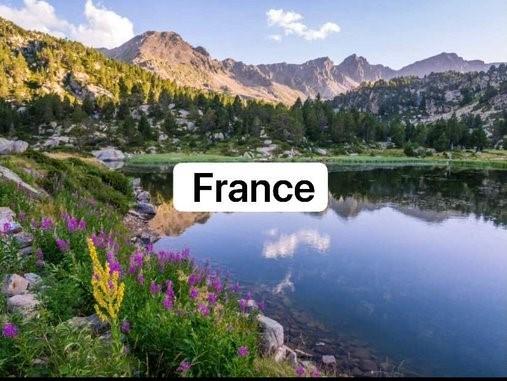
Several other images from this set were identified, showcasing European countries.
There is also a sense of nostalgia to much of the representations as they can also depict a pristine or pre-modern world unblemished by industrialisation. This worship of the rural, with a back-to-the-land idyllic focus on pastoral ways of living before the disruptions caused by modernity, shares many commonalities with the Nazi German notions of ‘blood and soil’ (Biehl and Staudenmaier, 1996).
Images portraying isolated cabins or idyllic homesteads (Figure 2) surrounded by wild nature appeal to a strong anti-urbanist sentiment within the eco-fascist subculture as well as a personal desire to be anchored within the scenery. With much of this imagery going back in time there is a sense of nostalgia for before industrialisation, immigration and multiculturalism, when native white populations were the sole custodians of the land and lived immersed in nature. Traditional white families foraging for food or tending to animals, display romantic fantasies of an idealised lifestyle. Together, these images encapsulate what is being mourned for and what is desired to be restored in the eco-fascist utopian vision.

Spirituality and Mysticism
Nature is also characterised in spiritual or mystical terms. Images include clouds or lightning bolts shaped like humans, animals, or ancient pagan spiritual figures. Trees which bear a striking resemblance to a human heart, or shapes on tree bark that appear as human eyes (Figure 3). It is unknown how much of this content consisted of edited images, but while lacking any context, they seemingly serve to offer proof that elements of spirituality are inherent within nature. This was clearly articulated in a post featuring an image of an ancient olive tree known as “The Thinking Tree” in Puglia, Italy, which strongly resembled a man deep in thought, with the accompanying text entertaining such ideas, stating: “Things like this would make it very easy to be Animist” (Animism relates to the idea that all natural objects contain their own spirit and are alive).

Images like this depicted spiritual elements inherent within nature.
Continuing the attachment of supernatural qualities to the natural world, some images are clearly edited, portraying tree branches or roots which tangle together to form the shape of doorways or portals to another realm. This mystification of the environment serves to ‘spiritualise’ nature as powerful and deeply connected to something beyond the material world. Images of forests or mountains in the dataset also included captions explicitly related to vague senses of spirituality such “Nature is my Church” (Figure 4), or “Worship Nature”, depicting nature as a form of spiritual sanctuary and homeland.
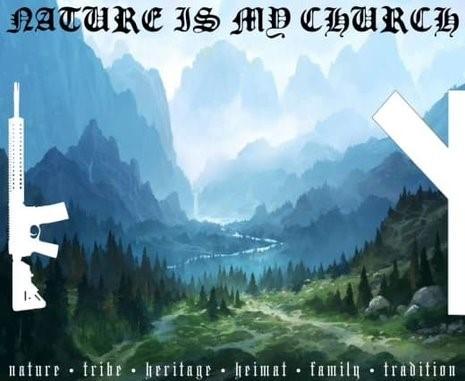
Another prominent representation of spirituality and mysticism in nature often related to paganism and folklore, with pagan style art and folk culture imagery typically featuring a natural setting, serving to invoke the connection between the White race and their ancestral traditions through connecting their spirituality to the natural environment. In reinforcing this exclusive connection, the content also reinforces an external ‘othering’ of those deemed to be nonnatives.
Far-right symbolism
There is a heavy use of far-right symbols and messaging accompanying depictions of nature. The visual effect of these images is they appear to represent a neo-Nazi ‘stamp of ownership’ on natural landscapes and are so distinct to the eco-fascist subculture they incorporate its ‘brand’. The most common symbol to appear is the Algiz or ‘life rune’(ᛉ), a Norse rune once appropriated by Nazi
Germany (ADL, 2022) and used for the SS’s Lebensborn project (which focused on promoting the increase in Aryan population birth rates). During the post-war era the rune became popular among neo-Nazis.
The Algiz rune has become the primary insignia of choice for the ecofascist community, and commonly appears in their propaganda imagery alongside nature scenery, frequently superimposed over woodlands and natural landscapes. In some contexts, it appears to carry an almost religious-like reverence, representing a fascist spiritual infatuation with the natural. In one striking example (Figure 5), a green Algiz rune appears standing upright like a crucifix alongside a solitary wooden house with a forest and mountainous landscape background. Directly below, in dark red, an inverse Algiz rune, associated with ‘death’ (Reporting Radicalism, no date) appears against a city backdrop of skyscrapers and apartment buildings, illuminating how the symbol has been co-opted to represent an idealised way of life in opposition to modernity.

Anti-urbanism messaging expressed through inverse Algiz rune.
The Sonnenrad symbol, also known as the Sunwheel or Black Sun, is the second most common symbol to appear in eco-fascist imagery and propaganda. The distinct wheel insignia featured as a design on a marble relief in Heinrich Himmler’s Wewelsburg castle, which was set to be the spiritual home of the SS (Hinde, 2021). Today it is widely popular among neo-Nazi’s, even being used by the neo-Nazi Azov Battalion in Ukraine (Miller, 2018) and displayed on the front cover of Tarrant’s 2019 manifesto. More recently it was also worn by Gendron, the Buffalo shooter, during his May 2022 shooting attack (ADL, 2022a). In eco-fascist propaganda, however, the Sonnenrad wheel often appears looming in the sky (Figure 6) or floating over mountaintops or forests with a cosmos-like aura as if taking the place of a rising sun or moon (Figure 7).
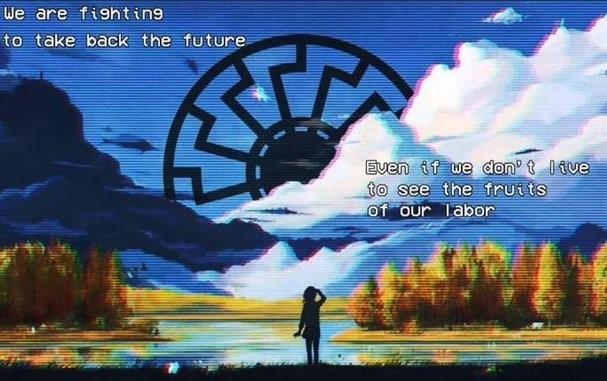
Sonnenrad appearing like a rising sun, promising a new dawn. The glitchy aesthetic invokes the feelings of nostalgia while the message promises of a future utopia.

Nature imagery featuring the sonnenrad often casts the symbol with an almost planetary quality.
The use of these fascist symbols, which serve as stamps of ownership upon various depictions of the environment, make an explicitly political ‘blood and soil’ statement about white identity and the natural landscapes. They also seed an idea of fascism as an inherent force within nature, casting the environment as the key battleground, within which a fascist spirit can be reawakened. Together, these images constitute the eco-fascist ‘brand’, as they remain the most distinct form of eco-fascist propaganda imagery which can distinguish itself from other far-right material across the Terrorgram ecosystem.
Return. Embrace. Defend.
Finally, much of the messaging accompanying propaganda imagery of nature can be summarised as calling on followers to ‘return’, ‘embrace’ or ‘defend’ nature. These calls seem to outline a pathway towards salvation by rejecting modern urban life, living closer to nature and reconnecting with a spiritual connection lost to modernity, before finally committing to defend what is thus rightfully theirs.
Captions urge followers to “return to nature” or to simply “return home”, claiming ownership over nature as the rightful natural habitat of those deemed native to the land, while also characterizing nature as a spiritual homeland. To live in nature is to return ‘home’ (Figure 8), to the natural order and way of life, rejecting the alienation of suburbs and cities and getting back in touch with ancestral roots.

Other variations used the German word ‘Heimat’.
Calls for followers to “embrace”, “commune” or “connect” with nature or simply to “go outside” seek to reawaken what is seen as a lost connection with nature. Messaging accompanying representations of nature speak to a sense of spiritual ‘wholeness’ which can be attained in nature when removed from modern urban life, with captions including: “create a life you don’t need a vacation from”.
Indeed, there is a strong and significant body of research which points to the benefits of experiencing nature for mental health and wellbeing (Berman, Jonides and Kaplan, 2008; Keniger, Gaston, Irvine and Fuller, 2013; Robbins, 2020) yet calls to return to nature often aligns with their more extreme messaging, such as a call to “revolt against the modern world”. Another iteration relates to encouraging followers to learn how to grow food, hunt or fish, with slogans calling on followers to get “back to basics” and “become selfsufficient”, sometimes tied closely to a means of getting back at the system by dropping out to “starve the beast”.
Alongside this messaging of returning to, embracing, and connecting with nature is the call to “defend nature”. Graphics and propaganda feature Nazi symbols imposed onto images of landscapes alongside captions calling on followers to “defend the wild”, “protect” or “save” nature and seek to characterise the threat as an ‘other’ which must be fought through violent means. One such image with the slogan “protect nature” features a German Wehrmarcht infantryman crouched in a woodland (Figure 9), while others call for more direct militancy and violence against those responsible for harming forests. One main cipher for this form of messaging across the ecofascist community is Ted Kaczynski, also known as the Unabomber, whose image is prevalent across eco-fascist networks. Kaczynski will also be discussed in a later section, as will a more detailed exploration of his overlap with themes of militancy.
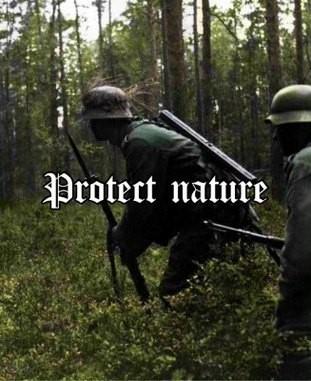
Images such as this appear to equate nature with race. The ‘other’ in these contexts is never explicitly identified.
While depictions of nature vary across the dataset, they can be broadly summarised as portraying both a past world lost to modernity and a possible future white supremacist utopia. They transmit both feelings of loss, pride, and emphasise the exclusiveness of the relationship between race and nature through casting the natural environment as a spiritual homeland for Whites. The message broadcast to followers is to return and embrace nature, in what Staudenmaier has referred to as “racial salvation through a return to the land” (2011 p.26). The final stage and logical conclusion of this relationship requires a commitment to ultimately defend nature through violent means. Nature in this sense is instrumentalised for identity formation and weaponised to mobilise actors to commit to violence on its behalf.
4.1.2. Outgroups/Ingroups
Rhetoric targeting specific outgroups appeared alongside discourse forming a White ingroup identity. Outgroups were also defined through what Berger refers to as a “narrative process of identity construction that parallels the construction of the in-group definition” (2018 p.57) in which ingroup formation ‘pushes out’ the other.
What emerges is a typical worldview of hate consistent with neoNazism, with little to distinguish the eco-fascist subculture from other far-right movements. The two dominant outgroups to appear were Jews, followed by African Americans. A White ingroup identity was repeatedly reinforced throughout the dataset, often through the promotion of ancestral pride and historical connections to nature, by linking Whites to what is characterised as their native ecosystem.
Jews were by far the most common outgroup to emerge within the dataset, with antisemitism appearing frequently in the form of tropes common across the broader far-right. Jews were characterised as conspiring to undermine the white race, using corrupting influences such as pornography, communism, and feminism to weaken and subjugate whites. They were portrayed as having total control of the US media and the US government and were accused of using their economic and political power to weaponize the Black community and “colored hordes” of the developing world against White populations. Violence against Jewish people was often encouraged (Figure 10).

Antisemitic content attempting to attach itself to animal rights message. This font and style are typical of Siege-culture material.
Calls for followers to become self-sufficient or live in nature were promoted as a means of breaking free from Jewish control, with one user declaring: “Don't let the jew in the box take hold of you”. Others accused Jews of being out of sync with the environment, accusing them of “heavily modifying nature and the world to suit their needs.” Or believing “themselves to be above the world, instead of among it.” Meanwhile, narratives also emerged regarding health, with conspiracies casting Jews as behind the spreading of false information about certain food products deemed by the eco-fascist community to be naturally good for Whites, such as raw milk. A similar logic informed antivaccine narratives.
The second most referenced outgroup in the data set was African Americans. They were typically labelled with racial slurs and dehumanising language. Much of the content related to Black on White crime in the US, such as screenshots of news articles reporting on black men killing or raping Whites. White victims of Black violence were appropriated as martyrs (Figure 11) and Blacks were described as a “threat to white nations”. They appeared in cherrypicked CCTV footage or fight videos committing violent assaults, murders, and robberies. One typical video included a compilation of footage of brutal violence carried out by Black men against White victims, while the accompanying audio featured a mash up of voices discussing White privilege and threats posed by White supremacy. The purpose of such content was clearly geared towards provoking a strong emotional reaction. One such piece of content was labelled “hatefuel”.

An Uber driver murdered by an African American man in 2022 was featured alongside a quote recorded from her in-car camera shortly before she was killed. This type of material was intended to provoke a strong emotional response.
It is notable the outgroup discourse indicates a notable focus on USbased Jews and African Americans in particular, suggesting a significant proportion of channel admins appeared to be in North America. This was further highlighted with another distinct outgroup singled out, namely US-based police.
A second observation is prominent, this is, outgroups in the dataset indicate no strong animosity towards those who work for fossil fuel companies or the logging industry, for example. In fact, there was hardly anything in the outgroup discourse to differentiate eco-fascism from other far-right ideologies. Other than several posts directed towards ‘urbanites’ or ‘technophiles’, the ecofascist subculture failed to produce a distinct prominent outgroup in relation to the environment. Posts which focused on individuals deemed to be responsible for harming the environment failed to explicitly tie the message to a particular group (Figure 12).

A rare example of threats directed towards those responsible for environmental harm fails to identify targets. Statements such as this were typically vague.
However, a sentiment more distinct to eco-fascism emerges when reinforcing a link between the natural environment and ingroup ‘indigenous’ white populations that excludes non-natives. A focus on ancestral links to the land through reviving folklore and paganism serves to reinforce the link between the territory and the White race. Meanwhile, a sense of pan-racial solidarity is encouraged as users are urged to support their “fellow whites” and be proud of their identity by reminding followers of their ancestral legacies with apparent motivational statements, including: “The blood that runs through your veins is unstoppable”.
However, the majority of ingroup discourse revolves around the naturalness of Whites to their native ecosystems, thereby highlighting outgroups also in the process. This was particularly present with discourse related to Europe, take for instance the below text:
“The reason why Whites have a special bond with nature. A soul incarnates in a specific body having specific genetic attributes and traits in order to grow in a given environment that will stimulate and further the spiritual evolution of that individual. Each race is designed for/by a particular habitat...
A Black person per se is misplaced in a continent like Europe, and spiritually deprived. Lost. In my years of hiking and wandering in the many European forests and mountains, never do I recall encountering a dark-skinned individual. Blacks don’t camp nor hike, ski, or climb mountains. They're even known to make fun of us for it. They cannot grasp any of it.
The reason is that the mountains and European nature more generally, does not call them. Europe speaks and calls her children. Our Gods who live in our blood, are calling us back home”.
The above excerpt explicitly exclaims what is typically heavily implied through much of the representations of nature within eco-fascist visual culture: the land is a natural ecosystem of whites, and other races do not belong there. In this regard, the same black men who are seen committing violent crimes in the streets, either against whites or one another, are easily portrayed as a foreign and invasive species, harmful to the white ecosystem. Likewise, the Jewish globalist elites portrayed as using immigration and corrupting influences to harm White homelands quickly become characterised as a foreign parasite, surviving by weakening their host.
It is arguable there is a major contradiction with this narrative for USbased eco-fascists however, who may struggle to claim the same native ties to
North American natural ecosystems as Europeans. Although this issue was never confronted or discussed in the dataset, Campion (2021) has noted that in settler societies a select community can make the same privileged claims on territory.
This message merges within the broader context of returning, embracing and reconnecting with nature. Whites are called upon to return to what is deemed to be their spiritual homeland, their natural environment. In urging followers to defend, protect or save nature, the message is accompanied with weapons of violence, such as rifles. In this sense, the threat is portrayed as an ‘other’ who must be fought. The message to defend nature is not calling for petitions, climate change activism or protests. The message is calling for killing an invader who, through the outgroup formation, is characterised as a foreign species, disrupting the harmony between Whites and their ecosystem.
4.1.3. Militancy
The appearance of what is categorized as militancy had a strong presence in the dataset indicating a high degree of overlap with accelerationist and Siegeculture networks. The militancy label accounts for an umbrella group of narratives and messaging surrounding violence, ranging from calls for sabotage to the sharing of tactical skills knowledge and the glorification of terrorism, all the way up to directs calls for targeted killing. Also categorised under the militancy label is a category of visual culture called ‘terrorwave’ (@Jake_Hanrahan, 2018) comprised of militant aesthetics and broadly popular across the Terrorgram subculture.
The most distinct form of militancy to eco-fascist subculture was sabotage. Examples ranged from guidance on ‘ecotage’ taken from scanned pages of “Ecodefense: A Field Guide to Monkeywrenching”, a manual used by early ‘Earth First!’ activists, detailing equipment and gear required for tree spiking, which demonstrated an interesting engagement with reading material beyond far-right texts.
Other examples of sabotage focused on the targeting of infrastructure sustaining modern civilization, with an extensive array of posts calling for attacks on the power grid, particularly electrical substations, and transmission towers. Many of the posts went well beyond inspirational material, but outlined practical steps for action, like highlighting vulnerabilities to the US power grid.
One such post pointed out that if nine key substations were to be taken out and disabled, the US would suffer a coast-to-coast blackout. The purpose of these posts was to inspire others to carry out such actions. The content aligned with militant accelerationist aims, with the overall strategy for such actions aimed at provoking societal collapse (Figure 13).

Image accompanied by the below text: “📺 No matter how bad it gets, as long as the modern man has his TV and his paycheck things will never change. 🧨 Therefore the only solution is to take these things from him. [REDACT] your local power substation. [REDACT] your local railway. [REDACT] your local amazon center. [REDACT] your local grocery store”.
Other content praised far-right terrorists like Dylann Roof, who shot and killed nine black worshippers at a Church in Charleston, South Carolina, in the US in 2015, or Brenton Tarrant, the perpetrator of the 2019 Christchurch Mosque attack. Posts included montage videos celebrating shootings and acts of terror, such as the 2019 El Paso attack targeting Latinos or the 2018 Pittsburgh Synagogue shooting. Infographics also celebrated older far-right terrorists such as David Copeland, the 1999 London nail bomber who targeted black, Bengali and LGBT communities.
The glorification of terrorism within the broader Terrorgram subculture was so prevalent that a Siege-culture calendar dubbed the ‘Saints Calendar’ commemorating important ‘Days of Action’ existed celebrating anniversaries of far-right terrorist attacks, the birthdays of perpetrators or the dates of their arrests. The calendar itself was a private dedicated channel not included in the dataset. But the highly networked nature of Telegram meant that posts were regularly forwarded across the far-right Telegram community, including Ecogram, ensuring the glorification of terrorism was heavily ritualised (Figure 14).

Post commemorating the Oklahoma bomber on the anniversary of his attack. Similar posts were identified for other terrorists on the anniversary of their attacks, including Christchurch attacker.
A channel admin posting on April 18h, the day before the Oklahoma bombing anniversary, demonstrates the anticipation of these dates and how the process of collective commemoration serves to goad others into carrying out similar actions, or contribute to the collective ritual of glorification: “IT'S
SAINT MCVEIGH DAY EVE, TERRORBROS! CAN'T WAIT TO SEE EVERYONE'S OC TOMORROW!!! 🚚💣😀” (“OC”, stands for ‘original
content’, and along with the ‘truck’ and ‘bomb’ emoji, can be interpreted as a veiled suggestion for others to conduct similar ‘original’ attacks of their own, or to encourage others to produce original edited images and propaganda commemorating McVeigh).
Other forms of militancy included the sharing of tactical advice and tips for urban warfare, from how to make an ‘urban ghillie suit’, to advanced guides and manuals on infantry tactics, medic training, improvised munitions and advanced sniping skills. While some of the texts included US military manuals, most were related to insurgency theory and tactics, such as the Irish Republican Army’s ‘Green Book’. Two particularly popular texts were Taber’s War of the Flea: The Classic Study of Guerrilla Warfare and Fry the Brain: The Art of Urban Sniping and its role in Modern Guerrilla Warfare, both of which were also reported to have appeared in the Pine Tree Party Telegram channel in 2020 (Shajkovci, 2020). Thus, highlighting how militancy often manifests in the form of promoting insurrectionary violence aligning with the doctrine outlined in Siege.
Beyond waging warfare and insurgency advice, there are more extreme calls for violent action. In one example, articles about security services fearing drones could be used to target stadiums in a terrorist attack were shared alongside a clip featuring People’s Defence Forces militants in Myanmar using a drone to drop improvised explosives onto a military base. In this context, the intentions of the author were clear, the post hoped to inspire similar attacks targeting civilians. There were also explicit calls for targeted assassinations. During the data collection phase, the names and addresses of individuals were observed to be posted onto ‘kill lists’. While these posts were not collected, due to ethics, privacy and data concerns, their prevalence throughout the data requires acknowledgement.
Another aspect of militancy related to propaganda and the so-called terrorwave aesthetics, a common feature across broader Terrorgram (Figure 15). This typically includes images from conflicts across the world which give a war a dreamlike visceral and glossy quality, or edited images of combatants to appear in a fuzzy VHS style haze and has been described by British journalist Hanrahan as removing “the reality of the violence war brings, whilst also showing how bored young men in the West desire a violent past they've no perception of” (@Jake_Hanrahan, 2018).

This glitchy aesthetic is a common feature of terrorwave content. Nostalgia and militancy combine to construct attractive agents of violence, removed from the reality of conflict.
In short, terrorwave images attempt to portray war as cool, or edgy. A prime example of this phenomenon in the dataset often features recognisable members of the Provisional Irish Republican Army, whose distinct 90’s era style of guerrilla chic has become particularly iconic within the broader Siege-culture community (Figure 16). Edits of photographs of gunmen from this era appeared frequently, often with far-right symbolism and Siege-style aesthetics applied. Terrorwave images also featured armed men alongside slogans like: “zero compromises in the defense of nature” or “be nice to trees”.

A format of propaganda typical of Siege-culture using an iconic image of a Provisional IRA gunman. Many images were found to use 1990s-era IRA gunman as templates, demonstrating a strong fixation on aesthetics.
Overall, the theme of militancy highlights the presence of Siege-culturelinked violent tendencies, which demonstrates that militant accelerationism has a notable influence on how the eco-fascist subculture identifies itself as a community and how it aims to express its grievances through violent means. There is a focus on pushing society towards collapse through a series of wellplaced attacks, with an emphasis on infrastructural sabotage, while other elements of militancy serve to demarcate the ingroup as a dedicated vanguard of “terrorbros” who adhere to rituals of commemoration for a lineage of white supremacist violence in which they can insert their own actions into. Propaganda seeks to glorify terrorism and make militancy appear attractive, with a focus on aesthetics and identity appearing to be more prominent than justification for action.
4.2. Eco-fascism themes
In this second section, we will outline the four main themes found after the analysis and connect each theme with either eco-fascism, Siege-culture or the conceptual frameworks previously discussed.
4.2.1. Kaczynskian anti-technology radicalism
A strong rejection of the modern world is often channelled into what is being termed Kaczynskian anti-technology radicalism (Fleming, 2021). Kaczynskian anti-technology radicalism in the dataset is characterised by an adoption and co-option of the ideology of Unabomber Ted Kaczynski. Of all the themes which will be discussed, this will be the most extensive, as Kaczynski is the most prevalent individual to appear in the dataset and serves as the key ideological figure whom eco-fascists have coalesced around.
Kaczynski’s writings are considered a bible for the eco-fascist community. Members glorify his terror campaign and deploy Kaczynski as a messaging device for calling for violence and the sabotage of infrastructure with militant accelerationist aims. His deliberate decision to live a solitary life in the wilderness is widely admired, with memes, edited propaganda images referencing his early life as well as his later crimes. More broadly, he is depicted as a legitimate ambassador for nature in the eco-fascist imaginary, as someone who returned, embraced and defended nature.
The salience of Kaczynski’s anti-technology radicalism is the most distinguishing ideological tendency of the eco-fascist subculture. Each of Kaczynski’s writings were shared extensively. Propaganda images included masked men holding copies of his texts, such as his 1995 manifesto Industrial Society and its Future, his 2010 Technological Slavery and his 2016 Anti-Tech Revolution: Why and How. Copies of his prison correspondence also appeared, as well as instructions on how to write letters to him. Kaczynski’s antitechnology writings were clearly influential and required reading across the ecofascist community, with Kaczynski celebrated in one post sharing his writings as a “freedom fighter and true hero of humanity”.
Kaczynski’s reoccurrence in the visual culture is also immediately striking. His cause is adopted and promoted with distinct fascist aesthetic branding. Images include edits in the signature style of neo-Nazi Siege-culture digital artist ‘dark foreigner’ (Makuch and Lamoureux, 2021), alongside militant captions including “Defend The Wild” (Figure 17), “Destroy Industrial Society” or “Anti Tech Generation”. On numerous occasions, the skull mask associated with Siege-culture groups such as Atomwaffen Division was edited onto his face (Figure 18), in a process Micheal Loadenthal (Loadenthal, 2022) has also observed and described as the “Siege-ification of the deep green,” or the “Kaczynski-ization of the neo-Nazi”.
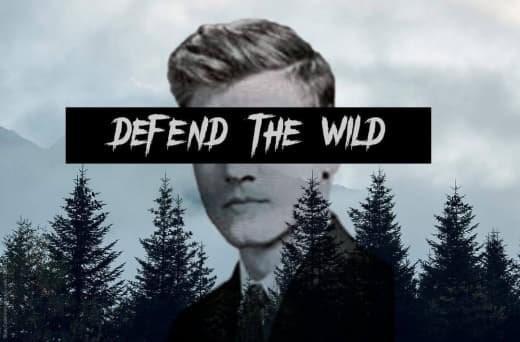
Portrayal of the Unabomber in a font and style distinct to Siege-culture. In this image, “Defend The Wild” appears to appropriate his cause to defend ‘wild nature’.

He is featuring red laser eyes also typical in Siege propaganda.
Other notable images of Kaczynski included far-right symbols popular among eco-fascists such as the sonnenrad, the swastika or Norse Algiz runes or featuring a glitchy terrorwave aesthetic gloss. Dozens of images of his cabin in rural Montana also appeared edited in a similar fashion. FBI crime scene photos taken inside his cabin emerged, as well as images of his arrest and court appearances. His life story and crimes clearly carry a lot of meaning for the community as much as his ideological legacy. This was demonstrated by the reoccurrence of family photographs taken of a younger Kaczynski prior to his bombing campaign, as if some users identified with his reported early feelings of alienation.
Sometimes these images featured quotes from his later writings on revolutionary struggle, such as the justifying the use of violence, or the overthrow of the techno-industrial system. Notably, many of the quotations chosen are applicable to insurrectionary white supremacist armed struggle as well, highlighting the ease with which further cross-pollination can take place between content produced by the Ecogram networks and the much more Siegefocused communities on Telegram and vice versa (Figure 19).
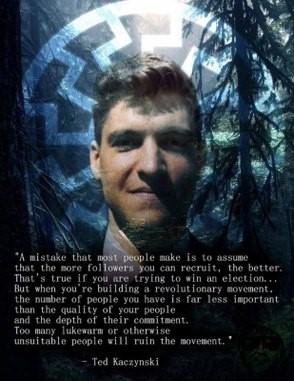
Quotes such as this, on the importance of commitment over size for a successful revolutionary movement, can be flexibly applied to Siege-culture accelerationism.
Kaczynski was also nicknamed ‘Uncle Ted’ or revered with spiritual importance with ‘Saint Ted’, having been honorarily canonised (Walther and Mccoy, 2021) by the wider Siege community as a ‘saint’ alongside far-right terrorists Tarrant, Breivik, Crusius and Roof. The dates of his bombings and his birthday are marked in the so-called ‘Saints calendar’, in which the commemoration of far-right terrorists has become heavily ritualised. As one of many “warrior-saint icon’s” (Am and Weimann, 2020) of the far-right religion, Kaczynski can be regarded as serving as the ‘patron saint’ (Figure 20) of the eco-fascist subculture, but also worshipped as a Siege-culture saint at the same time.

While a Siege-culture saint, Kaczynski can also be considered to be adopted as the ‘patron saint’ of eco-fascism.
Overlapping with the previously discussed theme of militancy, a frequent usage involved deploying Kaczynski as a messaging device for calls for violent action. His image was often instrumentalised for attempting to inspire acts of sabotage, particularly targeting vital infrastructure sustaining modern civilization like electrical substations. Examples included a clip taken from the 2021 ‘Ted K’ film, of the character of Kaczynski chopping down wooden electricity pylons in a forest accompanied by the caption: “Revolt Against the Modern World” or a superimposed grinning Kaczynski over a headline reporting on a Department of Homeland Security warning domestic extremists planned to target the power grid.
Kaczynski was also used for more direct calls for violence against individuals. Propaganda images called on followers to “finish what he started”. Bill Gates, frequently the target of far-right conspiracy theories (Greenspan, 2021), is singled out in one post with an image of Kaczynski’s arrest mugshot and the caption “Bill Gates has an address”. Text accompanying the image exclaimed: “Many technocrats addresses are publicly available, and many have no security guards”, suggesting members of the tech industry as viable and soft targets. Similarly, one image (Figure 21) featuring Kaczynski in orange prison garb with a black rectangle over his eyes and the slogan “I speak for the trees”, positions Kaczynski’s murders as legitimately representing nature. This latter slogan is an example of an iteration in an evolutionary chain originating with the eco-fascist appropriation of The Lorax in their propaganda, which deployed the same slogan and was previously identified by Smith (2021).
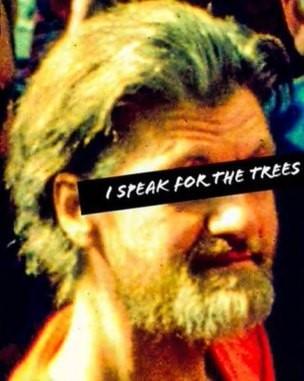
Discussions about eco-fascism as an ideology in the mainstream media have typically focused on Finnish deep ecologist Penti Linkola neo-Malthusian views on overpopulation, and seldom reference the influence of the antitechnology ideology of Kaczynski (Minna Stern, 2019; Owen, 2019; Rockey, 2021), whose writing is referenced more frequently and whose image features most prominently in the visual culture of eco-fascist networks. Similarly, most scholarly work focusing on ecofascism which does reference Kaczynski as a key thinker, often includes him as one of several influential figures (Macklin, 2022; Ross and Bevensee, 2020). However, when we look at eco-fascism ‘proper’, as the subculture on Telegram, Kaczynskian anti-tech radicalism appears to be much more formative for the community. If anything, it can be considered the guiding ideology behind the subculture on Telegram, as noted by Hughes, Kaczynski is the “ideological and aesthetic tie that binds together fragmented ecofascist tendencies” (Hughes, Jones and Amarasingam 2022 pp.1004-1005)
Furthermore, radical neo-Malthusian argumentation failed to emerge as a distinct theme by itself within the collected dataset. Instead, anti-technological and anti-civilizational anarcho-primitivism surfaced regularly, often with Kaczynski as a cipher, but sometimes even as a standalone sentiment (Figure 22). What makes this phenomenon particularly unique is that Kaczynski is not a far-right figure. Nor has he ever considered himself as an eco-fascist.

Anti-technology radicalism emerged as a distinct theme sometimes without requiring Kaczynski as an explicit messaging device.
In fact, Kaczynski has explicitly disavowed both. In a publicly available prison letter from 2020 he claimed the white supremacist beliefs held by ecofascists could never be effective in achieving a global anti-tech revolution, nor could it coexist with their aim to create a planned society, stating he considered himself an “adversary” (Kaczynski, 2020). In his 2010 Technological Slavery, he dismissed Nazism as a “kook ideology” (Kaczynski, 2010 p.150), and in another publicly available prison letter, he accused Hitler of exploiting what was an “anti-civilizational current” (Kaczynski, 2017) in German society.
These major contradictions in his writings with eco-fascism and neoNazism reveal a somewhat complex relationship between Kaczynski and the ideological views of the eco-fascist subculture. He holds huge importance for the eco-fascist community, where the popularity of his texts offers perhaps the single most important element of ideological cohesion. Yet he lacks what one would suspect would be crucial white supremacist beliefs.
The overlap between Siege-culture and Ecogram networks on Telegram offers a likely explanation for the origins of this relationship. The prevalence of content featuring various iterations of Siege-aesthetics applied to Kaczynski comes as no surprise, as Kaczynski is also extremely popular across the broader Siege-culture milieu, with Kaczynski granted an honorary form of sainthood, upheld as one of their “holy trinity” alongside Oklahoma bomber Timothy McVeigh and Norwegian far-right terrorist Anders Breivik (Taylor, 2019) and members of Atomwaffen Division reported by Der Spiegel journalists to have previously written to Kaczynski in prison (Epp and Höfner, 2018).
Another direct link can be traced to the loose online Pine Tree Twitter subculture (Hanrahan, 2018), which was initially mostly devoted to Kaczynski, with ‘Pine tree’ emojis still used to denote eco-fascist Telegram channels. A distinct ''Ted Gang'' was also active as a micro-culture within Pine Tree Twitter. Moreover, Mike Ma, founder of the linked ‘Pine Tree Party’, which was described as a movement promoting self-sufficiency and a return to nature “to escape the grasps of government control” (Shajkovci, 2020) has been noted for standing out for his praise of Kaczynski (Hughes, Jones and Amarasingam, 2022). The writings of Mike Ma, who suggests violent actions for supporters of accelerationism including the blowing up of power stations, has been described as “broadly congruent with Kaczynski’s critique of technological civilisation and its deleterious effects upon freedom, autonomy, and the “anti-beauty” of modernity that was hastening man’s mental deterioration” (Macklin, 2022, p. 986).
The official Pine Tree Party Telegram channel was one of the first major channels to emerge within the eco-fascist subculture on the platform (Shajkovci, 2020), so perhaps had significant influence during a formative period for the subculture. Mike Ma, as the most prominent key influencer to emerge from the eco-fascist milieu may have helped popularise Kaczynski to an extent along with his followers. Ma has previously sold Kaczynski-branded merchandise (Mike MA, 2020) and his official Pine Tree Party website features an archive of all Kaczynski’s texts and prison correspondence (Mike MA, no date).
There are also ideological overlaps which can help explain the continued embrace of Kaczynski within the eco-fascist subculture (Farrell-Molloy and Macklin, 2022). His anti-technological diatribes fit comfortably into the antimodernism inherent to eco-fascist subculture and his ideas have a strong intellectual resonance with broader far-right anti-modern traditions (Staudenmaier, 2022). He is easily endorsed as a role model and symbol of militant resistance as his personal example of breaking from society to live a solitary life immersed in nature is widely admired (Figure 23) (Farrell-Molloy and Macklin, 2022), as is his bombing campaign, as evidenced by propaganda glorifying his actions. His terroristic credentials particularly appeal to the ecofascist subculture as it shares the same ecosystem as Siege-culture, where veneration of terrorism and militancy is the norm.

Content praised his hermit-like existence as well as his violence or ideology. His lifestyle appeared to represent a large part of his appeal to the community.
His preoccupation with defending “wild nature” is also easily moulded by eco-fascists to incorporate into their struggle to restore a lost natural order and hierarchy (Farrell-Molloy and Macklin, 2022), making him an easily adaptable figure for their cause. Similarly, his overall strategy of instigating a civilizational collapse sits comfortably alongside the accelerationist doctrine of Siege-culture-linked groups, who see in Kaczynski’s ideology a blueprint of potential targets for accelerationist violence, from the power grid to the tech industry, elevating Kaczynski as “an obvious sage of violence” for those who embrace collapse (Loadenthal, 2022).
But Kaczynski’s embrace by eco-fascists as well as Siege-culture could partly be explained by his recent rediscovery and surge in popularity among broader ecosystems on the right (Christ, 2021). His critiques of leftists, whom he described as driven by “feelings of inferiority” and “over-socialization” (Kaczynski, 1995) have been praised on White nationalist and alt-right podcasts (Counter-Currents, 2021; Paisios & SuperLutheran, 2018) for being well ahead of their time, and his image is featured prominently in white nationalist memes as a figure absorbed by the “Nazi periphery” (ADL, 2021; Stall and Grober, 2022).
However, while certainly a surge in popularity, this is not an entirely new phenomenon, as Kaczynski always exerted a niche appeal on the far-right fringes. In 2018, the neo-fascist party Golden Dawn published a translation of his manifesto (Fleming, 2021). Kaczynski's critiques of leftism and technology have also resonated with Men's Rights Activists (Gallagher, 2021). Right-wing users on 4chan's /pol/ board have applied a racial dimension to his words in coopting his ideology, while threads exploring his ideas on Stormfront have been found as far back as 2002 (Amend, 2020; Christ, 2021). Some far-right activists have admired Kaczynski ever since his arrest. In fact, the white power band Mudoven recorded an antisemitic song praising him and entitled Unabomber on their 1996 album 'Hate' (Eyes on the Right., 2018).
Across the eco-fascist subculture, a hostility towards the modern world is channelled into the anti-tech radicalism of Kaczynski. There has always been a degree of ideological overlap between Kaczynski’s ideology and the far-right, which may help explain how Kaczynski is so easily embraced by eco-fascists. Symbolically, his terroristic credentials and overlap between his neo-luddite ideology and militant accelerationist tendencies of eco-fascists offer further potential explanations as to why he is so prominent throughout analysis. As demonstrated, this also often overlaps with the theme of militancy, with Kaczynski deployed as a revolutionary symbol for inspiring violent action and alongside calls to target vital infrastructure.
4.2.2. Anti-Urbanism
The next theme is anti-Urbanism. Across the dataset a highly common aspiration of channel admins is the desire to remove oneself from society and modernity, escape from cities and live in near isolation in the wilderness. While the emphasis is mostly placed on the aspirational aspects of rural living and a much lesser proportion of the content is devoted to anti-urbanism rhetoric itself, the theme has been named as such because the context is clearly one of seeking an escape from modern urban life, and therefore can be characterised as hostile to urban living, as will be discussed in the following section.
As will also be explained, while on the surface, this theme may not always seem extremist in nature, it goes well beyond an idealisation of rural living and serves as radical expression of anti-modernity in that followers seek to extract themselves from modern society entirely, promoting the growing of food for self-sustainability and even the home-schooling of children. At the heart of this action is preservation of race, while other elements can sometimes focus on ‘prepping’ discourse, depicting the move to rural isolated areas as necessary for survival.
The most common occurrences of this subtheme are posts related to rural homesteading. These typically include educational posts on growing food, gardening and becoming self-sufficient. Some individuals document their own efforts and share photos of harvests, recipes, advice on growing food, and updates on their progress. There are also constant calls for the rest of the community to take up rural homesteading themselves (Figure 24). The promotion of this lifestyle is less about building sustainable communities or being environmentally friendly. It is instead inherently political in nature, and seeks to break away from the ‘system’, as articulated by one user:
“It is my deeply held belief that everyone in this community should be working towards, in whatever capacity they can, the goal of rural homesteading. Organic, decentralized, regenerative agriculture is one of our keys to success. Not only will you be happier, healthier and more capable of raising a large family, but you also become much harder to control. They want dependence, every step you can take to become less dependent on the system is a positive one.”

The call to adopt this lifestyle also features an emphasis on white family building, with messages urging the taking up of rural homesteading accompanied by calls to “start a family” and have “many beautiful white children”. Images of idyllic homesteads can also include idealised utopian visions with white mothers and white children surrounded by nature or farm animals. These extremist racial dynamics behind the calls for homesteading are most clearly expressed by a user who labels their land as their “hatestead”, or another who proudly displays an SS flag alongside their large harvest of chicken eggs (Figure 25). Messaging also includes calls to home-school children, emphasising how closely their ideas are tied to the desire to break away from the system, and can overlap with traditions established by other far-right movements such as US-based extremist Christian fundamentalists (Cariboni, 2022; Marley, 2004).

The goal of rural homesteading is also heavily laden with conspiratorial overtones. The “system” is referred to as being controlled by a “(((they)))”. The use of triple parentheses is a coded antisemitic term for jews, indicating the belief that the Jewish people benefits from keeping whites in cities where they are easier to control and manipulate. The call to drop out of the system is a call to “starve the beast” and deny elites power through their control of the food supply. The widely held aspiration of breaking away from the system for ecofascists is summarised by one user, albeit with a degree of irony: “There’s a neoNazi plan to do nothing besides read old books, drink eggs, lift weights, raise chickens, plant gardens, and breed lots of cis white persons in a heteronormative patriarchy while laughing at us as society collapses... and it’s terrifying”.
Meanwhile, another variation of this messaging relates more to the individual, rather than family building. Some community members use memes and propaganda imagery to express their desire to isolate themselves alone from the rest of society, with images typically portraying a remote cabin or lodge deep in the wilderness. This type of cabin imagery accounts for much of the content in this subtheme. Captions describe an alienation from society and modern life as drivers for desiring to be left alone. The prevalence of this desire for solitude and escape from modernity can also help explain the popularity of Kaczynski, whose cabin-in-the-woods lifestyle appears to be as attractive to many as his ideology and militant actions. Another key figure who also appeared and can be associated with this theme is Henry David Thoreau, whose 1854 work ‘Walden’ documents his two yearlong spartan-like experiments of living alone immersed in nature. Passages from the text were regularly referenced. Kaczynski and Thoreau have much in common, both men deliberately lived alone in the wilderness and “formulated similar worldviews” (Oleson, 2005).
The strong hostility shown towards cities and urban civilisation emerges in memes and propaganda comparing cities unfavourably to rural life (Figure 26), with dreary apartment buildings and city streets juxtaposed side by side with traditional cottages and idyllic homes in the countryside. Urban living is depicted as an unnatural bleak and alienating existence while rural life is portrayed as a natural way of life that can offer true fulfilment. In multiple memes and text posts, cities are described as facing an inevitable collapse. Rural homesteading in this context is thus accompanied with a prepper mindset, with self-sufficiency promoted as survivalist preparation for what is perceived to be the inevitable downfall of society.
[[f-b-from-blood-and-soil-to-ecogram-15.jpg][Figure 26. “Reject the concrete jungle, come home to nature and beauty”.
Messaging not only promoted ruralism but contained anti-urban messaging.
The subtheme of anti-urbanism is strictly anti-modern and nostalgic in nature. The utopian and idyllic ways of life are labelled as “old ways” (Figure 27). This is perhaps most perfectly illustrated in one such image of a wooden cabin in the countryside captioned: “going back to a simple life is not a step backwards” and the text: “there is a future in the past after all”. Old photographs documenting rural life surface to remind followers they have strayed away from traditions followed by their ancestors, who lived more fulfilling lives closer to nature. The central idea expressed here is that there must be a revival of these old ways of living, which are regarded as an antidote to the ‘degeneracy’ and lack of satisfaction offered by modern urban life, as described by one user: “The old world order is - Grow your food. Own your land. Create family. Tradition. Community. Honor. Learn from your ancestors. Build your own. Hunt. Explore. Barter/trade. Think, Write, and Speak your mind. The new world order is - Shop. Rent. Credit. Individualism. Trend.
Obey. Follow. Porn. Escape. Apathy. Blame. Drugs. Etc.”

Featured: “It's time to return to something closer to the Old Ways. There is a FUTURE in the past after all”.
For the eco-fascist subculture, the white race must leave the cities to be in “harmony with nature, in-tuned with their local ecosystem” and “attached to their native land”. The latter has been expressed, for example, by one admin who compares the urban fox to the white race, who has been “mistreated, corrupted and pushed to the edge”, its habitat replaced by modernity and its “lands destroyed”.
The deep hostility towards cities and the idealisation of nature and simplicity of rural life is comparable to the late 18th century romanticism movement which emerged in response to the dislocations produced by the industrial revolution and is also traditionally present in fascist thought. Antiurbanism was very much a volkisch motif, with a “back-to-the-land emphasis” (Biehl and Staudenmaier, 1996) of the German youth movement, which later became incorporated into and particularly prevalent in Nazi German propaganda (Biehl and Staudenmaier, 1996). In more recent years in the US, there is a history of far-right and militia movement activists establishing compounds and segregating themselves from the rest of society (Crockford, 2021).
However, the anti-urbanist fetishization of rural homesteading among the eco-fascist subculture is less militant in character. It is also framed less as a broader national volk project and appeals more to a small movement-wide and individual-level aspiration. In the literature covered for contextualising and complementing this thematic analysis, rural homesteading did not appear to be connected to any specific far-right influencer or thinker. While it is conceivable that a source from which this discourse originates was missed during the background research, similarities are believed to be, in part at least, observed with broader trends in the digital space.
It is notable that the presence of rural homesteading coincides with the rising mainstream popularity of so-called “cottagecore” aesthetic which surged during the pandemic (Heathcote, 2021). Cottagecore has been described by the New York Times as a “budding aesthetic movement… where tropes of rural self-sufficiency converge with dainty décor to create an exceptionally twee distillation of pastoral existence” (Slone, 2020). But cottagecore has come also under fire for pandering to a “right-wing dog whistle”, in which “Visions of national identity and traditional, patriarchal gender relations are often grounded in a mythology of the rural” (Ollivain, 2020).
It has become particularly popular among ‘tradwives’, a far-right aesthetic and ideological movement encouraging women to embrace patriarchal gender norms. As described by Cooksey (2021), in an era of climate anxiety the cottagecore aesthetic offers them the dream of a “stable microclimate in which they can own a house, grow their own food, and live a happy life”.
Gender plays a core role in eco-fascist homesteading discourse. Women serve as idealised mothers and obedient ‘tradwives’. Across the dataset women rarely appeared or were mentioned outside of the rural patriarchal family fantasy context. Scenes of white women bonding with or caring for their children in a rural setting were the most popular. Noticeably, these types of images excluded the male, as if the fantasy guided the image selection towards that of the constructed male perspective (Figure 28), placing the viewer in the imaginary role of the patriarch, gazing at his family away from afar. This imagery appeared to attempt to appeal to the viewer on a personal level, presenting a fantasy which appeared to resonate for the individual emotionally and less on a broader ideological movement-wide utopia.

Images tended to appeal to the individual on a personal level through the transmission of a fantasy life.
While it may be difficult to draw a direct line to the rise of cottagecore, it is worth noting that the trend appears to coincide with the emergence of the eco-fascist tendency towards rural homesteading and may provide an outlet of expression for the anti-urbanism inherent within eco-fascism. Moreover, the symbolic importance of the ‘tradwife’ for the eco-fascist community as the idealised female partner in ruralism discourse provides a possible link to the popularity of the cottagecore aesthetic movement (Figure 29).
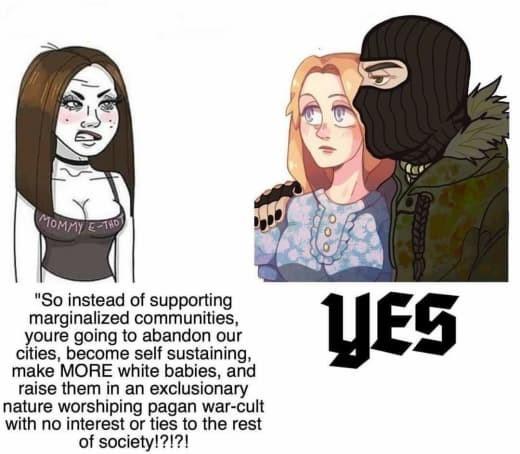
A meme featuring a woman in a blue floral dress associated with the ‘tradwife’ meme was featured in eco-fascist propaganda.
4.2.3. Atavism-Masculinity
Another prominent theme was atavism, specifically relating to masculine values. A cult of masculinity within the eco-fascist subculture looks to ancient warrior cultures and seeks to rebuild the man in alignment with what is perceived to be the ideal man in his most 'natural' state as he was ‘genetically designed’ to be. The modern world is believed to have produced weak and effeminate men and this is held partly to blame for the degeneracy of society. Therefore, it is considered that ‘strong men’ are needed to ‘restore order’. This world view is very much one in which there is a cyclical view of history, and often summarised in far-right propaganda with the words of the author G. Michael Hopf: “Hard times create strong men, strong men create good times, good times create weak men, and weak men create hard times” (Devereaux, 2020).
The atavistic masculine values idolised by the community are seen as a means of both enabling men to escape the shackles of the modern world through personal development, while also establishing a bulwark cadre for defending the white race. There are two central means in which this theme typically emerges. The first is through the idolising of ancient warriors from the primordial European past, the second is through an emphasis on health, with a particular focus on diet.
Warriors
The most common feature of atavism typically includes historical illustrations and artworks depicting ancient warrior cultures (Figure 30). There is a fixation on hunter-gatherer lifestyles, Vikings, Norsemen, ancient Germanic tribesmen as well as Ancient Greece and Rome. Images typically convey a sense of nobility, pride and courage. Stills from the popular historical drama 'Vikings' also featured, sometimes accompanied by quotes on brotherhood or masculine ideals of strength and honour. Some of the posts appeared to serve an educational purpose, with informational text appearing alongside some of the images, aiming to foster a sense of pan-European racial self-awareness. Together, these images tell a story of a white shared historical and cultural past while also serving as idealised examples of what values men should strive to reawaken in themselves.

Images such as these channelled atavistic ideas of masculinity.
Beyond ancestral pride, the worship of these figures presents selected atavistic values as natural and inherent to masculinity. The most prominent of these values is violence. Virtually all the images which emerged represented men with sword, spear or axe in hand, engaged in battle, or hunting in the wild. An image forwarded from far-right author Raw Egg Nationalist’s channel of
Greek god Zeus, contains the slogan “ALL MEN SHOULD BE DANGEROUS” (Figure 31), encouraging men to embrace violence as a natural primitive masculine characteristic. Posts heavily lamented the illegitimacy of violence as a means of solving disputes in modern society, including a quote which appeared multiple times, purportedly from Conan creator Robert E. Howard: “Civilized men are more discourteous than savages because they know they can be impolite without having their skulls split”.
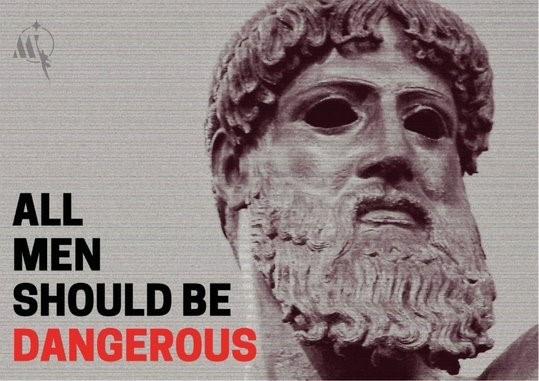
A direct line can be drawn from this very idea to a strong promasculinity culture proliferating within the far-right ecosystem and revolving around several key influencers. This includes ‘The Way of Men’ far-right author Jack Donovan, whose “tactical virtues” (Donovan, 2014) of strength, courage, mastery and honor are hailed as the most important masculine values, or neoVolkish hate group the Wolves of Vinland, which organises itself around “archaic notions of gender” (SPLC, no date a). Both were said to have been a major influence on Lyndon McLeod, a far-right author responsible for shooting five people dead in a killing spree in Denver in December 2021. Lyndon also appeared in a post in the dataset, in which he is quoted venting frustrations about how the modern world disallows physically strong men to inflict violence to defend their honour (Figure 32) (Kriner, Upchurch, and Aaron, 2022).

A quote from McLeod references ideas related to a ‘natural’ atavistic sense of masculinity suppressed by modernity.
Health
For the eco-fascist subculture if white men should aspire to be like their ancestors, they must live like them too. This provides a pathway of personal development with a focus on physical health. Images portray strong muscular warriors who present a role model which aligns with the hypermasculine 'Chad' archetype, a caricature borrowed from incel culture featuring a strong chiseljawed man with exaggerated muscles (Mattheis, 2019) which is popular among far-right meme culture. A core step towards imitating these figures involves rejecting modern foods and embracing a diet like one believed to have been eaten by their ancestors, as explained best by one user:
“The ancestral approach to health and wellbeing is the best path to mending the injured soul and body. If we can eat and move like our ancestors did, then we would be well on our way to ideal health and wellness. It is as if our genetics as Hyperboreans gave us a blueprint on how to live and eat a certain way, and we, through progress and amenity, have forgotten how to do it. Spending time in nature, not just for a escape from modernity but engaging with and embracing primality can fill the void leaving an empty hole. Eat a primal diet! Meat, fish, fowl, eggs, vegetables, fruits, nuts and seeds promote energy. Excess insulin from modern convenient foods (chemically altered fats) leads to burnout, fatigue, disease, unnecessary weight gain, and dependency on carbs.”
Seed oils were also often singled out for their perceived harm. Similarly, soy-based products were believed to be detrimental for building muscle mass and said to increase men's estrogen levels and decrease their testosterone. Plant and insect-based foods were demonised (Figure 33), as was veganism for ‘making men weak’. Instead, there was a strong emphasis on the consumption of more primal-style foods, with works of alternative nutritionist and foods rights activist Aajonous Vonderplanitz quoted several times and the practice of consuming raw meat referenced on several occasions.

Novel sources of protein were demonised.
The most advocated food in the dataset was raw milk (Figure 34), which was often tied to racial superiority. Meanwhile, health warnings associated with the consumption of raw milk were in turn said to be conspiratorial attempts to undermine the white race:
“Raw milk is the life blood of our people. We are the only race on earth which is able to properly digest milk, nearly all European people have a genetic mutation called “lactase persistence”. While almost all other populations on earth lose their ability to digest lactose after being weened, we maintain this ability our entire lives. (((Conventional wisdom))) would have you believe that something our exponentially healthier ancestors have done for thousands of years is the most dangerous thing ever, but nothing could be further from the truth. Ignore doctors, honour your ancestors, drink raw milk”
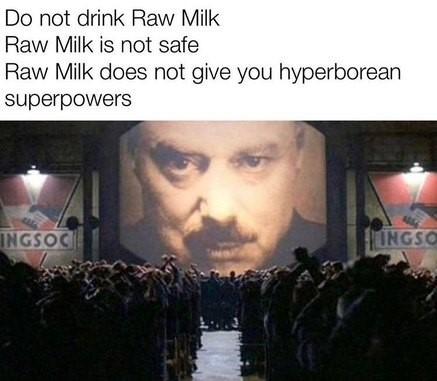
Described as a superfood for whites associated with strength and subject to conspiracy theories.
This discourse is strikingly similar to views held by Mike Ma, himself an anti-xenoestrogen activist whose website describes himself as "a proponent of raw milk, raw eggs, raw organs'' (Mike MA, no date a; Dysart, 2019) and features links to sites warning of the dangers of fluoride in tap water and lists locations for buying raw milk. The end of his latest novel, Gothic Violence, includes a ‘nutrition addendum’ which declares that "the world of today is more desperate for a dietary renaissance than any other point in time", warning against the consumption of fluoridated tap water, packaged foods and seed oils, while also calling on his followers to "eat meat and drink raw milk every day" while also drawing upon the work of Vonderplanitz himself.
The conspiratorial ideas surrounding food can also likely be traced to a growing network of key far-right activists who focus on food as a key issue area, including the most influential voices in the so-called ‘dissident right’. One such activist is Raw Egg Nationalist (RWE), editor of self-published ‘Man's World’ magazine and author of esoteric cookbook Raw Egg Nationalism, published by the white nationalist Antelope Hill Publishing company. 'Raw Egg Nationalism' describes itself as "a physical and political ethic built around the massive consumption of raw eggs", promoting 'slonking' a 36-raw-eggs a day diet said to have been followed and perfected by American bodybuilder Vince Gironda (Gais, Squire, Wilson and Hayden, 2022). RWE is highly active on Twitter and his ‘Man's World’ magazine frequently discusses diet and features full page ads promoting the consumption of raw milk, raw honey, animal fats or olive oil. Mike Ma’s Harassment Architecture and Gothic Violence are also advertised regularly in Man’s World with full page ads, highlighting a clear overlap with eco-fascist tendencies.
These ideas are becoming closely tied to ‘Great Reset’ conspiracy theories. Writing in 'Man's World' in his article 'Beyond The Wall: Becoming a barbarian in the age of the grain state', Raw Egg Nationalist states: "If we care about freedom today, we need to think carefully about the relationship between control of the food supply and social control. The Great Reset, the latest iteration of the globalists’ plan for world government, has at its centre a new agricultural revolution" (2022 p.111). This ‘new agricultural revolution’ is perceived to be a radical overhaul of how we produce and eat food as a means of tackling climate change and a response to projected population growth.
According to the theory, "Globalists" will oversee the removal of meat and dairy products from our diet and replace our food consumption with novel sources of protein such as plant-based and lab-grown meat. Insect-based foods occupy a particular fixation in this dystopian vision, in which an elite continues to live on a luxurious meat-based diet while ordinary people are forced to live in small 'pods' and subsist on bugs, views which were also found to have emerged in the dataset (Hay, 2021).
Another prominent figure in this milieu is the pseudonymous Bronze Age Pervert (BAP), who's now banned Twitter bio described himself as a “Free speech and anti-xenoestrogen activist” (Yalcinkaya, 2022). BAP is host of the "Caribbean Rhythms with BAP" podcast and author of self-published Bronze Age Mindset (2018), a cult classic among far-right internet circles that promotes atavistic masculine virtues rooted in classical antiquity as a means of enacting political change (Schreckinger, 2019). While much of his discourse is characterised by trolling (Burton, 2018), his project has been described as ''unmistakably fascistoid" (Hugues et al., 2022).
BAP fixates on the aesthetics of the male human body and presents images that worship the "natural beauty of man", which he deems to have been buried by the modern "trash" world. One of the corrupting ills of the modern world he identifies relates to the modern food industry, described as full of harmful chemicals "that slowly destroy your essence", blaming the pollution of the earth's waters on chemicals emitted by "obese high-fructose-corn-syrupguzzling beasts". Crucially, BAP also believes the modern world and liberal order suppress masculine energy and glorifies the violence of the ancient world.
Together, their ideas surrounding diet and health attempt to revive what is deemed to be a communion with nature. The consumption of raw eggs, raw milk and raw meat offer high protein antidotes to “preserve masculinity” and “protect men” from a ‘degeneration’ caused by the modern world. These beliefs collide with efforts to downsize the meat industry, illuminating a conflict between the eco-fascist subculture and that of mainstream efforts to combat climate change. At the heart of this conflict, see values in contention with the perceived ‘natural order’, an idea of masculinity held dear by the eco-fascist community on the one hand, in conflict with scientifically informed attempts to protect the environment on the other.
The far-right uses masculinity to both problematise other effeminate, weaker men and to recruit, by persuading men they can regain their masculinity by fighting the ‘other’ (Kimmel 2018). The atavistic cult of masculinity on display in the dataset, which venerates physical strength and violent warrior values, has much in common with Connell’s (1995) concept of “protest masculinities”. For the eco-fascist subculture, their construction of masculinity relies upon re-establishing a perceived natural order and hierarchy in which violence and physical strength ruled. Although modernity limits the value of those resources, the embracing of such values can be regarded as an attempt to regain power and control in an imagined parallel world. The concept of protest masculinities is useful for illuminating this hyper-masculine overcompensation, rather than speculate on genuine marginalisation, although feelings of marginalisation may be very real.
The far right has a long history (Nilan, 2021) of turning to Aryan and Viking warrior myths for inspiration, as does the alt-right (Illing, 2019) with ancient Greece and Rome. Similarly, masculine ideals as a cornerstone of fascist ideology are not new. Nazi ’Germany's 'new man' ideal also imagined a strong male redeemer figure capable of leading a period of transformation into a new era, capable of recapturing "virtues which were being submerged in the modern world" (Mosse 1966 p.22). However, the eco-fascist subculture appears to draw heavily from rising contemporary thinkers who, while not eco-fascist themselves, comfortably overlap with their tendency towards an understanding of masculinity being suppressed in the modern world and of nature over science (Figure 35).
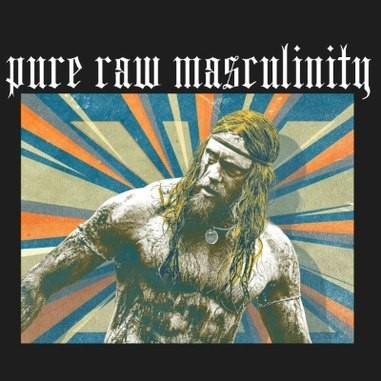
Posted with the caption: “What they fear”
The emphasis on violence as inherent to masculinity, and the situating of a primal-style diet as a counter to a ‘conspiratorial globalist agenda’ indicates strong ideological similarities with RWE and BAP. Both authors were named or referenced directly in the dataset. Given their popularity among the broader far-right, distinctness of their atavistic ideas and direct links to the eco-fascist subculture via Mike Ma, it is plausible to consider both to be periphery influencers of the eco-fascist subculture, who overlap comfortably in the territory of the eco-fascist obsession with the natural order.
4.2.4. Neo-völkisch
This section will explore how the theme neo-völkisch. is mediated- with an attempted revival of folklore and pagan traditions. The overriding purpose of the neo-völkisch theme is to denote a mystical connection between the land and race, reinforcing the 'naturalness’ of the in-group to the ecosystem, and thereby excluding the foreign outgroup, who lack the same deep historical and spiritual connections to the land.
As explained in an earlier section, nature itself can be portrayed through a mystical lens, transmitting a spiritual essence inherent within nature and seeding the idea the natural environment offers a spiritual homeland for the White race. In contrast, the neo-völkisch elements of paganism and folklore are the specific tools the eco-fascist subculture instrumentalises to anchor the White in-group identity to the land. Eliminating the forces of modernity, multiculturalism and industrialisation can therefore be presented as a means of reviving this lost connection between blood and soil.
Discourse relating to European folklore and mythology typically followed a format which included folk art illustrations accompanied by a short descriptive text. These posts were educational, with their introductory nature indicating the aim was to impart a history lesson upon their target audience (Figure 36). Other common images featured midsummer or maypole folk dances, women wearing flower crowns, and variations of nature cult aesthetics, such as the wearing of deer antlers (Figure 37). Many of the images and stories also took place deep in forests, emphasising an ancestral history tied closely to nature. Channel admins devoted a great effort towards encouraging the community to become more aware of folk traditions and the distinctness of their identity:
“Slavic, Celtic, Nordic, Finnish, Iberian, Greek, and all other ethnic Europeans we are indigenous people of this planet, and we do have all of the attributes that go with an indigenous culture. We have our own shamanism and nature-based spirituality. We have our own gods. We have our own traditions, customs, practices, rites, rituals, and ways. We have our own indigenous mythology, folklore... We are indigenous!”

This image was accompanied by a text description detailing so-called ‘Wild Women’ or ‘Female Hermits’ in German folklore.

Images such as this were common and typically featured women.
Throughout the dataset posts about folklore were regularly found to be forwarded from a network of Telegram channels which focused primarily on European cultures, traditions, customs and so on. Some of these channels were not always explicitly far-right in their discourse, but the political undertones to their content was unmistakably clear. The content was always focused on a panEuropean context and shared a similar aesthetic and style to that of right-wing ‘tradposting’ accounts on other platforms (@worth__fighting__for, no date). Across this network, a concerted effort was being made to highlight White European’s ancestral link to folk traditions and mourn their loss as a consequence of modernity and multiculturalism.
One folklore creature was embraced with ironic undertones and incorporated into the troll culture embedded into the DNA of far-right online movements (Hodge and Hallgrimsdottir, 2020). A reoccurring theme across discussions on folklore was a bizarre fixation on gnomes. Variations included a photoshopped 'Gigachad' in gnome attire, and multiple memes which clearly played to an in-joke within the community catering to so-called "gnomepill" or "gnomecore", described by 'knowyourmeme' (2021) as a series of memes that "humorously advertise gnomes" cozy, nature-appreciative way of life as a superior one" and claims that gnomes really exist.
Gnomecore discourse included elements of Esoteric Nazism, such as references to gnomes living in Hyperborea, a mythological Aryan civilisation followers believed was once inhabited by an ancient White race or included images of gnomes gassing Jews (depicted as goblins) (Figure 38). Another example included a story telling of peaceful gnomes living in a forest invaded by goblins (depicted with antisemitic tropes) who proceeded to chop down the trees to “finance their industries”. The story ended with the gnomes banding together to take up arms against the goblins, declaring “we need to defend this forest and secure our existence!”.

The gnome memes were a distinct subcultural phenomenon, symbolic of the overlap between far-right troll culture, white supremacy and the fascination with European folklore.
Paganism was also instrumentalised as a means of 'rooting' white people to the soil. This was done through a similar bridging of European ancestral spiritual traditions to nature and thus highlighting the unique connection to the land. Artworks referencing Norse, Celtic, Germanic, Slavic and Anglo-Saxon pagan symbols, traditions and deities were commonplace. Much of the material was also educational, highlighting a clear campaign to revive pagan beliefs and ideas (The most explicit attempt of which was a propaganda image with the call to "Make Europe Pagan Again") (Figure 39) and foster a similar sense of White identity awareness.
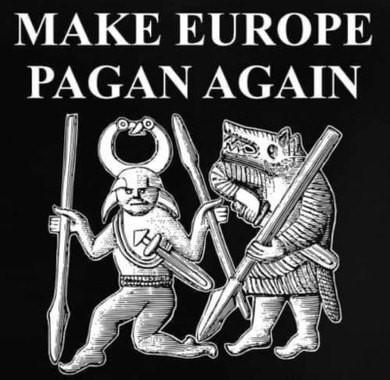
While the degree to which individuals were sincere about their belief in paganism is unclear, in co-opting pagan ideas the content served an important practical ideological purpose. In emphasising the role paganistic rituals and beliefs played in the lives of their ancestors, it served to highlight a unique spiritual ‘blood and soil’ link between whites and their native European ecosystems. For eco-fascists, this logic sits comfortably alongside their belief of an exclusive connection between the White in-group and their natural ecosystems. Paganism offers the spiritual bridge to fortify this link.
Meanwhile, the Christian faith was demonised and labelled an Abrahamic religion with no legitimacy, foreign to ‘real’ European traditions. Christianity was charged with removing spirituality from nature and placing it in an abstract place outside of earth. A misty-eyed yearning for re-establishing this connection with nature appeared to be a central attraction to paganism:
“The most important things for pagan/indigenous cultures were the ancestry/past generations… which of course went hand in hand with the native land, and native nature and the entire ecosystem. Each indigenous population were charged with being the caretakers of their own region”.
Other attacks on Christianity criticised the glorification of the crusades as an example of Christian strength, with claims they had ultimately achieved nothing but “hundreds of years of occupation from racial aliens”. These remarks highlighted how embracing paganism offers eco-fascists another distinguishing feature from other right-wing groups and movements, who have generally embraced and weaponised the cultural and historical legacy of the crusades against what they perceive to be the Islamisation of Europe (Roche, 2021).
Paganism has a history of being weaponised by fascists, who utilise Odinism and Norse mythologies as "meta-mythologies meant to unite over constructed memories of a lost golden era" (Hovdkinn, 2016). In The Occult Roots of Nazism Goodrick-Clarke outlines how ideas in respect of suppressed pagan priesthood and wisdom from the Ariosophists of Vienna, who combined German nationalist völkisch ideas, Aryan racial theories and occultism in the late 19th century, filtered through to Heinrich Himmler and became incorporated into Nazi religiosity (Goodrick-Clarke, 2004). The Nazi revival of paganism had similar antisemitic, anti-Christian and racist values that were also on display in this dataset. Another prominent historical figure who promoted paganism is Julius Evola, who mixed fascism and ‘Traditionalism’ and called for a “return to the Nordic pagan’s tradition” (Evola, 2018, p.18). Evola is hugely influential on Siege-culture groups such as Atomwaffen (Upchurch, 2021).
While overlap between Ecogram and Siege-culture make possible the Evolian ideological tendencies in Atomwaffen for seeding paganism’s thematic presence in eco-fascism, there was also a prominent eco-fascist periphery figure identified whose distinct ideas on paganism had many similarities to their own. Varg Vikernes’, a former musician in the Norwegian black metal band Burzum, was referenced many times. Vikernes rose to prominence following a series of arson attacks against historical wooden churches across Norway, which he claimed were in revenge for the desecration of pagan sites by the Christian church. In 1993, while in prison after his conviction for murdering Mayhem guitarist Euronymous, he founded the ‘Norwegian Heathen Front’, a neo-Nazi organization which followed a form of Germanic Neopaganism (GoodrickClarke, 2002).
Varg Vikernes has since referred to his belief system as “Odalism,” described as "fiercely anti-modern, heavily based on pre-Christian pagan values, and openly racist" (International Business Times, 2013). Vikernes’ Odalism seeks to revive and defend pre-industrial European pagan society. It is tied closely to the defence of Nordic and Germanic identity and is staunchly antisemitic, anti-Christian and anti-materialistic. Similarly, the National Socialist Black Metal scene, of which Varg was central, is fundamentally focused on critiquing modernity (CARR, 2021), a central tendency of ecofascist subculture. Of course, caution must be expressed in tying too direct a line to Varg to the popularity of paganism as a theme in the dataset, but his presence was certainly notable and a similar study on eco-fascist networks also noted Vikernes appearance (Hughes, Jones and Amarasingam, 2022).
In a similar fashion to Kaczynski, it is possible Varg’s ‘credentials’ gained from arson and murder have a strong appeal for a subculture in which elements venerate violence and terrorism. However, he was never portrayed in a similar aesthetic fashion as Kaczynski. He was also a contested figure within the subculture. One channel admin claimed “Vargism and its consequences has been a disaster for pagans”, (paraphrasing the famous first line of Kaczynski’s manifesto), demonstrating a degree of infighting over Vikernes interpretations of paganism. Elsewhere, there were also strong disagreements across the dataset over the proper practice of paganism, with some derided as “metaphorical pagans” or “McPagans”.
The relationship between eco-fascists and paganism as a spiritual belief system appears complex, but paganism remains to serve the community an important ideological function for identity formation and establishing in-group cohesion. With nature as an issue-area focus for the eco-fascist subculture, the spiritual closeness to nature claimed by paganism makes adopting it an obvious choice. Similarly, traditional folklore, often situated in a rural premodern setting, forces the historical relationship between White populations and their natural ecosystems to the forefront.
Goodrick-Clarke has referred to this contemporary phenomenon of paganist and folklore infused mysticism by the far-right as a ‘neo-völkisch revival’. He elaborates: “Just as the original völkisch movement arose as a defensive ideology of German identity against modernity in the late nineteenth century, this neo-völkisch revival acts as a defensive ideology of white identity against multiculturalism, affirmative action and mass Third World immigration” (2002, p.9). He explains that as groups elaborate their concerns with identity and ethnicity, they become drawn to the same themes as their German predecessors.
However, as seen in the prominence of anti-modernism discourse within eco-fascism, and the emphasis on reconnecting with nature in their articulation of paganism, we could certainly also consider expressions of mysticism seen in Ecogram as a defensive ideology against modernity as well. Identity and ethnicity may be tied closely to mysticism discourse to formulate a compelling ‘blood and soil’ narrative. But together, the result is that much of visual material which serves to instrumentalise elements of mysticism imagery blends together to form a distinct aesthetic brand to eco-fascist visual culture, portraying a simpler pre-modern world which aligns with their construction of a utopian ecofascist imaginary (Figure 40).

5. Conclusion
Together, the themes which emerged illustrate that the eco-fascism subculture on Telegram is not a coherent ideological movement but a melting pot of various 'green' tendencies from across the far-right eco-system unified by nostalgic anti-modernism and anchored in the belief of a natural order. These findings broadly align with our foundational understanding of eco-fascism taken from Campion’s definition as “a reactionary and revolutionary ideology that champions the regeneration of an imagined community through a return to a romanticised, ethnopluralist vision of the natural order” (2021, p.8).
However, we can potentially expand upon her definition with two core findings. The first is derived from the theme of atavism. The “natural order” she addresses cannot just be merely understood as a societal-level hierarchy. Instead, the idea of restoring a perceived natural order was incorporated into an atavistic cult of masculinity within the eco-fascist subculture. This entailed the articulation of a form of ancestral masculinity that drew upon ‘historical’ warrior cultures, characterised by values such as strength, honour and violence deemed as ‘natural’ and deeply inherent to masculinity. Simultaneously, the consumption of modern food products was rejected in favour of a ‘primal’ diet considered to be more natural, such as raw foods. In this sense, for the ecofascist subculture, the restoring of a natural order begins with the individual, as anti-modernity is assimilated into men's bodies. These values, orientated around masculinity, ultimately come in direct conflict with climate change through ‘Great Reset’ conspiracy theories, where eco-fascist gastropolitics clashes with efforts to decrease meat consumption through novel sources of protein which the community regarded as estrogenic.
The second, is that the eco-fascist subculture is characterised by extreme hostility towards modernity. While Campion acknowledges eco-fascists believe modernity has weakened their connection to nature, there was a sense of hostility which went beyond a mere rejection of the modern world. This sentiment was most clearly expressed through an adoption and co-option of Kaczynskian anti-technology radicalism. Kaczynski was worshipped while his violent cause on behalf of “wild nature” was reappropriated to be instrumentalised for eco-fascist calls to restore the natural order. The antimodernism inherent to his anti-technology ideology makes him an ideal figure for eco-fascists to coalesce around while the presence of accelerationist tendencies within Ecogram made Kaczynski’s terroristic credentials particularly appealing. The salience of his ideology was the strongest point of cohesion for the subculture, with his writings providing a guiding philosophy for the community and his life example incorporated into militancy discourse which frequently called for infrastructural sabotage. However, despite enthusiastically embracing his ideology, there is of course a major contradiction in that he is venerated in an online subculture.
Another theme associated with strong anti-modernity surfaced with antiurbanism in which calls to take up rural homesteading were fused together with a fierce resentment towards the urban. Cities were portrayed as soulless and alienating hotbeds of ‘degeneracy’, while a panacea was offered through the preservation and salvation of the White race via an escape to nature. This dichotomy between the pure rural and impure urban was a similar feature of Italian and German fascism (Campion, 2021). However, what distinguishes the romanticisation of the simplicity of rural life within the eco-fascist subculture from previous ‘back-to-the-land' ideas is the radicalism inherent to how aspirations of rural homesteading were framed. Members aspired to remove themselves entirely from the ‘system’, with calls for self-sufficiency and the home-schooling of children. Similarly, they embraced a fantasy of an idealised hermit-like existence, with an emphasis on being entirely alone in the wilderness. At the heart of these fantasies was either an idea of White familybuilding, far away from the ‘degeneracy’ of the modern world, or an individualistic escape and isolation from modernity.
The regeneration of an imagined community described by Campion is seen most clearly in the neo-völkisch theme, which invokes mystical ties to nature through folklore and paganism traditions, rooting the White race to their native ecosystems through a spiritual bridge in which they can claim an exclusive spiritual and historical link to nature. The educational nature of many of the posts can be considered an attempt to awaken a White ingroup identity, with a concerted effort to introduce their target audience to alternative beliefs which insulate them from the influence of Christianity. The social construction of this ingroup community is informed by a neo-völkisch ideology. While
Goodrick-Clarke (2002) places the emphasis on multiculturalism, affirmative action and Third World immigration when describing the causes for the neovölkisch revival, the presence of this ideology within eco-fascist subculture can also be regarded as deeply anti-modern in nature, as it also informs and interacts with utopian imagery of a premodern world.
Outgroup formation indicates that Ecogram is white supremacist and antisemitic. But there was little to distinguish the subculture from other neoNazi movements. The fixation on nature never materialised in the development of an outgroup related to environmental destruction. Meanwhile, the natural environment was used as the basis for constructing an imagined community ingroup and to justify racially segregated and exclusive rights to space. While white supremacism and antisemitism was expected, the failure to clearly articulate specific targets for violence who were perceived as responsible for environmental destruction was surprising. When the discourse surrounding the defence of nature or militancy on behalf of did emerge it was often as a rather vague sentiment.
The thesis also set out to clarify whether Ecogram could be best described as a Siege-culture-linked accelerationist subculture or as a distinct movement. The findings indicate that when attributing tendencies to Siegeculture or distinct ideological movements the picture is a complex one. While the eco-fascism subculture is a unique community which can be distinguished from broader Siege-culture, it overlaps and borrows many of its attributes, from the glorification of terrorism to promotion of militant accelerationism. A distinct visual culture fixated on nature, paganism, folklore and atavism as well as a concerted effort to promote rural homesteading are not typical features of Siegeculture. Similarly, tendencies which were salient could be linked to what appeared to be influential thinkers emerging as eco-fascist ‘periphery’ figures.
The clearest overlaps with militant accelerationism were evident in how Kaczynski was represented in the visual culture and themes of infrastructural sabotage which emerged. Kaczynski occupied the overlap between Ecogram and Siege-culture tendencies characterised by the glorification of terrorism and violence and could often be deployed as a messenger for violence.
Meanwhile, anti-Urbanism, appeared to be a unique attribute of ecofascism. The emphasis on rural homesteading was not an element found to be associated with Siege-culture. Nor was any far-right movement or influence found to be linked to the idea. Speculation suggests this may be a result of a merger between the recent popularity of ‘cottagecore’ aesthetic and the tradwife, who occupies a core role in the eco-fascist fantasy. However, it is possible a key thinker or influencer can be linked to promoting these similar ideas but was missed during the analysis.
Atavism was somewhat murkier but can be considered closer to a distinct element of eco-fascist subculture. A direct line could be drawn to Mike Ma, a key contemporary thinker associated with eco-fascism, especially from discourse associated with diet. However, while he occupies an overlap between Siege-culture and Ecogram due to his glorification of militant accelerationism, his ideas are situated more closer to Ecogram due to his association with the early beginnings of the community. Secondly, non-Siege-culture figures, namely Bronze Age Pervert and Raw Egg Nationalist, were found to both inform and interact with ideas related to masculinity through their common understanding of a natural order.
Lastly, the neo-völkisch theme, can be considered as more distinct to the eco-fascist subculture. While similar aspects are present in other far-right movements there is no such prevalence of similar themes surrounding folklore and paganism within Siege-culture. While the milieu of activists in Siegeculture draws upon the work of Evola, the embracing of paganism and folklore appears to be unique to eco-fascist subculture. Images associated with this theme can often interact and inform the eco-fascist utopian imaginary.
A key limitation relates to the interpretive nature of the study. The construction of themes may have been influenced by personal biases. Future studies could use multiple coders during the early stages of thematic analysis to minimise any margin of error. Secondly, in only examining the Ecogram community on Telegram, we are not deriving an analysis of eco-fascism more broadly, but only understanding a very fringe community. Future research could apply different perspectives such as a gender-focused, given the salience of masculinity for identity formation in the community.
6. Bibliography
@Jake_Hanrahan, 2018. There's a bit of an obsession on the Internet with "war aesthetics" and "Terrorwave" [Twitter]. 25 June. Available from: https://twitter.com/Jake_Hanrahan/status/1011294797171130370
@worth__fighting__for, no date. Traditional Aesthetics Instagram Profile [Instagram]. Available from: https://www.instagram.com/worth__fighting__for/?hl=en
ACHENBACH, J. 2019. Two mass killings a world apart share a common theme: ‘ecofascism’ Image without a caption. The Washington Post [online] August 18. Available from: https://www.washingtonpost.com/science/two-mass-murders-a-world-apart-share-a-common-theme-ecofascism/2019/08/18/0079a676-bec4-11e9-b873-63ace636af08_story.html
ACTION ZEALANDIA, 2020. March 2020 Action Summary [online]. 31 March. Available from: https://action-zealandia.com/actions/march-2020-action-summary]]
AJL, M. 2019. Eco-Fascisms and Eco-Socialisms. Verso Books [online]. 12 August. Available from: https://www.versobooks.com/blogs/4404-eco-fascisms-and-eco-socialisms
AMARASINGHAM, A., ARGENTINO, M., & MACKLIN, G. 2022. The Buffalo Attack. Cumulative Momentum of Far-right Terror. CTC SENTINEL. Available from: https://ctc.westpoint.edu/the-buffalo-attack-the-cumulative-momentum-of-far-right-terror/
AM, A. B., & WEIMANN, G., 2020. Fabricated Martyrs: The Warrior-Saint Icons of Far-Right Terrorism. Perspectives on Terrorism, 14(5) pp.130–147. Available from: https://www.jstor.org/stable/26940043
AMEND, A., 2020. Blood and Vanishing Topsoil American Ecofascism Past, Present, and in the Coming Climate Crisis. Political Research Associates [online]. 09 July. [viewed 15 July 2022]. Available from: https://politicalresearch.org/2020/07/09/blood
AN PÁIRTÍ NÁISIÚNTA (NATIONAL PARTY), 2022. Nationalists Cleaning up! – Caring for the Land, Caring for the People [online]. 08 May. https://nationalparty.ie/nationalists-cleaning-up-caring-for-the-land-caring-for-the-people
ANTI-DEFAMATION LEAGUE (ADL), 2017. Anti-Semitism on Full Display in Charlottesville [online]. 15 August. [viewed 09 July 2022]. Available from: https://www.adl.org/resources/blog/anti-semitism-full-display-charlottesville]]
ANTI-DEFAMATION LEAGUE (ADL), 2020. Groyper Army and "America First" [online]. 17 March. [viewed 09 July 2022]. Available from: https://www.adl.org/resources/backgrounders/groyper
ANTI-DEFAMATION LEAGUE (ADL), 2021. “White Boy Summer:” From Meme to Mobilization [online]. 29 June. Available from: https://www.adl.org/resources/backgrounders/groyper-army-and-america-first
ANTI-DEFAMATION LEAGUE (ADL), 2022. HATE SYMBOL: Life Rune [online]. 03 May. [viewed 16 June 2022]. Available from: https://www.adl.org/resources/hate-symbol/life-rune
ANTI-DEFAMATION LEAGUE (ADL), 2022a. Buffalo Shooter’s Weapons Covered in White Supremacist Messaging [online]. 15 May. [viewed 12 June 2022]. Available from: https://www.adl.org/resources/blog/buffalo-shooters-weapons-covered-white-supremacist-messaging
BAELE, S. J., BRACE, L., & COAN, T. G., 2021. Variations on a Theme? Comparing 4chan, 8kun, and Other chans’ Far-Right “/pol” Boards. Perspectives on Terrorism, 15(1), pp. 65–80. Available from: https://www.jstor.org/stable/26984798
BARNETT, B. A., 2015. 20 Years Later: A Look Back at the Unabomber Manifesto. Perspectives on Terrorism, 9(6) pp. 60–71. Available from: http://www.jstor.org/stable/26297462
BEDINGFIELD, W., 2020. How Telegram became a safe haven for pro-terror Nazis. Vice News [online]. 01 March. Available from: https://www.wired.co.uk/article/hope-not-hate-telegram-nazis][
BELLASSAI, S., 2005. The masculine mystique: antimodernism and virility in fascist Italy. Journal of Modern Italian Studies, 10(3) pp. 314-335. DOI: 10.1080/13545710500188338
BENNETT, T., 2019. Understanding the Alt-Right's Growing Fascination with 'Eco-Fascism'. Vice News [online]. 10 April. Available from: https://www.vice.com/en/article/vbw55j/understanding-the-alt-rights-growing-fascination-with-eco-fascism][
BERGER, J.M. 2018. Extremism. Massachusetts: MIT Press.
BERMAN, M. G., JONIDES, J. & KAPLAN, S., 2008. The Cognitive Benefits of Interacting With Nature. Psychological Science, 19(12) pp.1207– 1212. DOI: 10.1111/j.1467-9280.2008.02225.x.
BIEHL, J. & STAUDENMAIER, P., 1996. Ecofascism: Lessons from the German Experience. The Anarchist Library [online]. Available from: https://theanarchistlibrary.org/library/janet-biehl-and-peter-staudenmaier-ecofascism-lessons-from-the-german-experience][
BLACK, B. 2019. The El Paso shooter's manifesto contains a dangerous message about climate change. The Week [online]. 06 August. Available from: https://theweek.com/articles/857100/el-paso-shooters-manifesto-contains-dangerous-message-about-climate-change][
BLOOM, M., TIFLATI, H. & HORGAN, J., 2019. Navigating ISIS’s Preferred Platform: Telegram. Terrorism and Political Violence, 31(6) pp.1242-1254. DOI: 10.1080/09546553.2017.1339695
BOWMAN-GRIEVE, L., 2009. Exploring “Stormfront”: A Virtual Community of the Radical Right. Studies in Conflict & Terrorism, 32(11) pp. 989-1007, DOI: 10.1080/10576100903259951
BRACE, L., 2022. Investigating the far-right online: Using text data to understand online subcultures. In: Mair, M., Meckin, R. and Elliot, M. (Eds) Investigative Methods: An NCRM Innovation Collection. Southampton: National Centre for Research Methods, pp. 54-65. DOI: 10.5258/NCRM/NCRM.00004548
BRAUN, V., CLARKE., V., 2006. Using Thematic Analysis in Psychology. Qualitative Research in Psychology. 3(2) pp.77-101. DOI: 10.1191/1478088706qp063oa
BRAVE, J., 2019. The Environmental Movement Needs to Reckon with Its Racist History. Vice News [online]. 13 September. Available from: https://www.vice.com/en/article/bjwvn8/the-environmental-movement-needs-to-reckon-with-its-racist-history][
BRONZE AGE PERVERT. 2018. Bronze Age Mindset. Self-published.
BRYANOV, K., VASINA, D., PANKOVA, Y., & PAKHOLKOV, V., 2022. The Other Side of Deplatforming: Right-Wing Telegram in the Wake of Trump’s Twitter Ouster. In: Digital Transformation and Global Society. DTGS 202 - eCommunication: Online Discources and Attitudes. Springer, Cham. DOI:10.1007/978-3-030-93715-7_30
BURGESS, M., 2021. Switched to Telegram? You need to know this about its encryption. Wired [online]. 27 January. Available from: https://www.wired.co.uk/article/telegram-encryption-end-to-end-features
BURTON, T. 2018. The religious hunger that drives Jordan Peterson’s fandom. Vox [online]. 01 June. Available from: https://www.vox.com/2018/6/1/17396182/jordan-peterson-alt-right-religion-catholicism][
CAMPION, K., 2021. Defining Ecofascism: Historical Foundations and Contemporary Interpretations in the Extreme Right. Terrorism and Political Violence [online]. DOI: 10.1080/09546553.2021.1987895
CARIBONI, D., 2022. Top US homeschooling advocates say parents have ‘right’ to inflict pain. OpenDemocracy [online]. 18 July. Available from: https://www.opendemocracy.net/en/5050/homeschooling-hslda-spanking-lgbtiq-women-rights/
Centre for Analysis of the Radical Right (CARR), 2021. The Musical Is Political: Black Metal and the Extreme Right [online]. 11 August. Available from:https://www.radicalrightanalysis.com/2021/08/11/the-musical-is-political-black-metal-and-the-extreme-right/][
CECCO, L., 2022. Night-time attack on controversial Canadian gas pipeline site. The Guardian [online]. 23 February. Available from:https://www.theguardian.com/world/2022/feb/23/night-attack-controversial-canadian-fracked-gas-pipeline-site
CHRIST, K., 2021. Why Right-Wing Extremists Love the Unabomber. Lawfare [online]. 17 October. Available from: https://www.lawfareblog.com/why-right-wing-extremists-love-unabomber][
CLARKE, C. 2020. Trends in Terrorism: What’s On the Horizon in 2020? Foreign Policy Research Institute (FPRI) [online]. 02 January. Available from: https://www.fpri.org/article/2020/01/trends-in-terrorism-whats-on-the-horizon-in-2020/
CLARKE, C. 2021. Trends in Terrorism: What’s On the Horizon in 2022? Foreign Policy Research Institute (FPRI) [online]. 08 December. Available from: https://www.fpri.org/article/2021/12/trends-in-terrorism-whats-on-the-horizon-in-2022/
COMERFORD, M., 2020. Confronting the Challenge of ‘Post-Organisational’ Extremism. Observer Research Foundation (ORF) [online]. Available from: https://www.orfonline.org/expert-speak/confronting-the-challenge-of-postorganisational-extremism/
CONNELL, R., 1995. Masculinities. Cambridge: Polity.
CONWAY, M., 2017. Determining the Role of the Internet in Violent Extremism and Terrorism: Six Suggestions for Progressing Research. Studies in Conflict & Terrorism, 40(1), pp.77-98, DOI: 10.1080/1057610X.2016.1157408
CONWAY, M., SCRIVENS, R. & MACNAIR, L., 2019. Right-Wing Extremists’ Persistent Online Presence: History and Contemporary Trends. International Centre for Counter-Terrorism (ICCT) Policy Brief [online]. 25 November. Available from: https://icct.nl/publication/right-wing-extremists-persistent-online-presence-history-and-contemporary-trends/][
COOKSEY, M., 2021. Why Are Gen Z Girls Attracted to the Tradwife Lifestyle? Political Research Associates [online]. 29 July. Available from: https://politicalresearch.org/2021/07/29/why-are-gen-z-girls-attracted-tradwife-lifestyle
CORCIONE, A., 2020. What It Is, Why It’s Wrong, and How to Fight It. Teen Vogue [online]. 30 April. Available from: https://www.teenvogue.com/story/what-is-ecofascism-explainer][
COUNTER-CURRENTS, 2021. Ted Talk. [Podcast]. 26 April. Available from: https://counter-currents.com/2021/04/ccr-ted-talk/
CROCKFORD, S., 2021. Survivalists and Preppers. In: Crossley, J. and Lockhart, A. (Eds.) Critical Dictionary of Apocalyptic and Millenarian Movements. Available from: http://www.cdamm.org/articles/survivalists-and-preppers
DARBY, L., 2019. What Is Eco-Fascism, the Ideology Behind Attacks in El Paso and Christchurch? Gentlemen's Quarterly (GQ) [online]. August 7. Available from:https://www.gq.com/story/what-is-eco-fascism
DAVEY, J. & EBNER, J., 2019. ‘The Great Replacement’: The violent consequences of mainstreamed extremism [online]. Institute for Strategic Dialogue (ISD). [viewed 07 July 2022]. Available from: http://www.isdglobal.org/isd-publications/the-great-replacement-the-violent-consequences-of-mainstreamed-extremism/
DAVEY, J. & WEINBERG, D., 2021. Inspiration and Influence: Discussions of the US Military in Extreme Right-Wing Telegram Channels [online]. Institute for Strategic Dialogue (ISD). Available from: https://www.isdglobal.org/isd-publications/inspiration-and-influence-discussions-of-the-u-s-military-in-extreme-right-wing-telegram-channels/
DEVEREAUX, B. 2020. Hard Times Don’t Make Strong Soldiers. Foreign Policy (FP) [online]. 02 May. Available from: https://foreignpolicy.com/2020/05/02/hard-times-dont-make-strong-soldiers-warrior-myth/
DFRLAB, 2020. Terrorgram: A community built on hate. Medium. [online] DFRLab. 20 April. Available from: https://medium.com/dfrlab/terrorgram-a-community-built-on-hate-e02fd59ee329
DONOVAN, J., 2014. "What is masculinity?" - An Introduction to The Way of Men [video]. 19 October 2014. Available from: https://www.youtube.com/watch?v=i-JWqHlKpU8
DROOGAN, J. & PEATTIEM S., 2017. Mapping the thematic landscape of Dabiq magazine, Australian Journal of International Affairs, 71:6, 591-620, DOI: 10.1080/10357718.2017.1303443
DYSART, C., 2019. ‘A world on fire’. PSU Vanguard [online]. 3 June. Available from: https://psuvanguard.com/a-world-on-fire/
EPP, A. & HÖFNER, R., 2018. The Hate Network: Atomwaffen Division. SPIEGEL Gruppe [online]. 07 September. Available from: https://www.spiegel.de/international/the-hate-network-an-inside-look-at-a-global-extremist-group-a-1226861.html
EUROPEAN COMMISSION DIRECTORATE GENERAL FOR MIGRATION AND HOME AFFAIRS, 2021. Contemporary Violent Leftwing and Anarchist Extremism (VLWAE) in the EU: Analysing Threats and Potential for P/CVE [online]. 17 November. Available from: https://home-affairs.ec.europa.eu/whats-new/publications/contemporary-violent-leftwing-and-anarchist-extremism-vlwae-eu-analysing-threats-and-potential-pcve_en
EVOLA, J. 2018. Pagan Imperialism And Metaphysics Of War. Wewelsburg Archives.
EYES ON THE RIGHT., 2018. Alt-Right Podcasters Offer Praise For ‘Unabomber’ Ted Kaczynski. Angry White Men [online]. 30 January. Available from: https://angrywhitemen.org/2018/01/30/alt-right-podcasters-offer-praise-for-unabomber-ted-kaczynski/
FARRELL-MOLLOY, J. & MACKLIN, G., 2022. Ted Kaczynski, AntiTechnology Radicalism and Eco-Fascism. International Centre for CounterTerrorism (ICCT) [online]. 15 June. Available from: https://icct.nl/publication/ted-kaczynski-anti-technology-radicalism-and-eco-fascism/
FELDSTEIN, S & GORDON, S., 2021. Are Telegram and Signal Havens for Right-Wing Extremists? Foreign Policy (FP) [online]. 13 March. Available from: https://foreignpolicy.com/2021/03/13/telegram-signal-apps-right-wing-extremism-islamic-state-terrorism-violence-europol-encrypted/
FERNANDEZ, A., 2015. Here to stay and growing: Combating ISIS propaganda networks The Brookings Project on U.S. Relations with the Islamic World U.S.-Islamic World Forum Papers 2015. Centre for Middle East Policy at Brookings. Available from:https://www.brookings.edu/wp-content/uploads/2016/07/IS-Propaganda_Web_English_v2.pdf
FLEMING, S., 2021. The Unabomber and the origins of anti-tech radicalism. Journal of Political Ideologies, 27(2) pp.207-225. DOI: 10.1080/13569317.2021.1921940
FLOCK, E., 2021. The pipeline saboteurs. The Economist [online]. 11 November. Available from: https://www.economist.com/1843/2021/11/11/the-pipeline-saboteurs
FORCHTNER, B., LUBARDA, B., 2020. Eco-fascism ‘proper’: the curious case of Greenline Front. Centre for Analysis of the Radical Right (CARR) [online]. 25 June. [viewed 09 July 2022]. Available from: https://www.radicalrightanalysis.com/2020/06/25/eco-fascism-proper-the-curious-case-of-greenline-front/
FOREMAN, D., ABBEY., E., 1993. Ecodefense: A field guide to monkeywrenching. The Anarchist Library. [online]. Available from: https://theanarchistlibrary.org/library/various-authors-ecodefense-a-field-guide-to-monkeywrenching
GAIS, H; SQUIRE, M.; WILSON, J. & HAYDEN, M.E., 2022. White Nationalist Book Publishers Revealed. Southern Poverty Law Center (SPLC) [online]. 13 June. Available from:https://www.splcenter.org/hatewatch/2022/06/13/white-nationalist-book-publishers-revealed
GALLAGHER, B. 2021. Why far-right communities love the Unabomber. Daily Dot [online]. 21 May. Available from: https://www.dailydot.com/debug/far-right-unabomber/
GAUDETTE, T., SCRIVENS, R., DAVIES, G., & FRANK, R., 2021. Upvoting extremism: Collective identity formation and the extreme right on Reddit. New Media & Society, 23(12), pp. 3491–3508. DOI: 10.1177/1461444820958123.
GOODRICK-CLARKE, N. 2002. Black Sun: Aryan Cults, Esoteric Nazism and the Politics of Identity. New York: New York University Press.
GOODRICK-CLARKE, N., 2004. The Occult Roots of Nazism - Secret Aryan Cults and their Influence on Nazi Ideology. London: Tauris Parke Paperbacks.
GREENSPAN, R., 2021. How Bill Gates became a favorite target of far-right conspiracy theorists. Insider [online]. 26 February. Available from: https://www.insider.com/bill-gates-climate-change-block-sun-conspiracy-theory-fake-texas-snow-2021
GUHL, J. & DAVEY, J., 2020. A Safe Space to Hate: White Supremacist Mobilisation on Telegram. Institute for Strategic Dialogue (ISD). Available from: https://www.isdglobal.org/isd-publications/a-safe-space-to-hate-white-supremacist-mobilisation-on-telegram/
GUNZ, H. & SCHALLER, I., 2022. Antisemitic Narratives on YouTube and Telegram as Part of Conspiracy Beliefs about COVID-19. In: Hübscher, M., & Mering, S.V. (Eds) Antisemitism on Social Media (1st ed.). Routledge [online]. DOI:10.4324/9781003200499
HANRAHAN, J., 2018. Inside the Unabomber's odd and furious online revival. Wired [online]. 01 August. Available from:https://www.wired.co.uk/article/unabomber-netflix-tv-series-ted-kaczynski
HAY, M., 2021. COVID Truthers’ New Freakout: Being Forced to Eat Bugs. Daily Beast [online]. 03 February. Available from: https://www.thedailybeast.com/covid-truthers-new-freakout-is-over-supposedly-being-forced-to-eat-bugs
HEATHCOTE, E., 2021. What is cottagecore? ‘Your grandma but, like, hip’. The Financial Times [online]. 20 March. Available from: https://www.ft.com/content/b976052f-3727-47e9-9fab-aa405499425a
HEINRICH, A., 2021. ‘We are nothing without nature’- The emotional resonance of far-right ecologist online content in public Telegram channels. M.A. thesis, Utrecht University. [viewed 20 June 2022]. Available from: https://studenttheses.uu.nl/handle/20.500.12932/346
HELM, B., SCRIVENS, R. HOLT, T., CHERMAK, S. & FRANK, R., 2022. Examining incel subculture on Reddit. Journal of Crime and Justice, pp. 1-19. DOI: 10.1080/0735648X.2022.2074867
HERMANNSON, P. 2020. The Rapewaffen Telegram Channel. Hope NoT Hate. [online]. 23 June. Available from: https://hopenothate.org.uk/2020/06/23/the-rapewaffen-telegram-channel/
HINDE, M., 2021. A History of Western Spirituality, and The Corruption of Eden. UK: Troubador Publishing Ltd.
HODGE, E. & HALLGRIMSDOTTIR, H., 2020. Networks of Hate: The Altright, “Troll Culture”, and the Cultural Geography of Social Movement Spaces Online. Journal of Borderlands Studies, 35(4) 563-580. DOI: 10.1080/08865655.2019.1571935
HOVDKINN, E., 2016. The Myths of Norse Mythology. Religion going public [online]. 02 May. Available from: https://religiongoingpublic.com/archive/2016/the-myths-of-norse-mythology
HUGHES, B., 2020. “Pine Tree” Twitter and the Shifting Ideological Foundations of Eco-Extremism. The Loopcast [Podcast]. 11 January. Available from: https://www.theloopcast.com/e/pine-tree-twitter-and-the-shifting-ideological-foundations-of-eco-extremism/
HUGHES, B. 2019. "Pine Tree" Twitter and the shifting ideological foundations of eco-extremism. Interventionen [online], 14. Available from: https://violence-prevention-network.de/ueber-uns/publikationen/interventionen-zeitschrift-fuer-verantwortungspaedagogik/
HUGHES, B; JONES, D. & AMARASINGAM, A., 2022. Ecofascism: An Examination of the Far-Right/Ecology Nexus in the Online Space. Terrorism and Political Violence, 34(5) pp. 997-1023. DOI: 10.1080/09546553.2022.2069932
HUQ, E. & MOCHIDA, H., 2018. 'The Rise of Environmental Fascism and the Securitization of Climate Change'. Projections - MIT Department of Urban Studies and Planning [online]. doi:10.21428/6cb11bd5.
ILLING, S., 2019. Why the alt-right loves ancient Rome And Greece, too. Vox [online]. 6 November. Available from: https://www.vox.com/2019/11/6/20919221/alt-right-history-greece-rome-donna-zuckerberg
INTERNATIONAL BUSINESS TIMES, 2013. Is Varg Vikernes A Terrorist? A Brief History Of The Burzum Frontman's Neo-Nazi, Pagan Views [online]. 16 July. Available from:https://www.ibtimes.com/varg-vikernes-terrorist-brief-history-burzum-frontmans-neo-nazi-pagan-views-1348789
IZAK, K., 2022. Is there a decline in ecoterrorism? Przegląd Bezpieczeństwa Wewnętrznego, 14(26), 394–431. Available from: https://www.ejournals.eu/PBW/2022/Numer-26-2022/art/21485/
JOHNSON, B. & FELDMAN, M., 2021. Siege Culture After Siege: Anatomy of a Neo-Nazi Terrorist Doctrine. International Centre for Counter-Terrorism (ICCT) [online]. 21 July. Available from: https://icct.nl/publication/siege-culture-anatomy-of-a-neo-nazi-terrorist-doctrine/
JOHNSTON, N., 2022. Selling terror: a multidimensional analysis of the Islamic State’s recruitment propaganda. Australian Journal of International Affairs, 76:2, pp. 194-218. DOI: 10.1080/10357718.2021.1970714
KACZYNSKI, T. 1995. Industrial Society and Its Future. Available from: http://editions-hache.com/essais/pdf/kaczynski2.pdf
KACZYNSKI, T., 2010. Technological Slavery. US: Feral House
KACZYNSKI, T., 2016. Anti-Tech Revolution: Why and How. Fitch and Madison.
KACZYNSKI, T., 2017. Ted Kaczynski on Individualists Tending Toward Savagery (ITS). The Anarchist Library [online]. Available from: https://theanarchistlibrary.org/library/ted-kaczynski-ted-kaczynski-on-individualists-tending-toward
KACZYNSKI, T., 2020. Ecofascism: An Aberrant Branch of Leftism. The Anarchist Library [online]. Available from: https://theanarchistlibrary.org/library/ted-kaczynski-ecofascism-an-aberrant-branch-of-leftism
KAUFMAN, A., 2019. El Paso Terrorism Suspect’s Alleged Manifesto Highlights Eco-Fascism’s Revival. Hutfpost [online]. 04 August. Available from: https://www.huffpost.com/entry/el-paso-shooting-manifesto_n_5d470564e4b0aca3411f60e6
KENIGER, L., GASTON, K., IRVINE, K., & FULLER, R., 2013. What are the Benefits of Interacting with Nature? International Journal of Environmental Research and Public Health, 10(3) pp.913–935. DOI:10.3390/ijerph10030913
KNOWYOURMEME, 2021. Gnomepill [online]. Available from: https://knowyourmeme.com/memes/gnomepill
KRINER, M., 2022. An Introduction to Militant Accelerationism. ARC [online]. Available from: https://www.accresearch.org/shortanalysis/an-introduction-to-militant-accelerationism
KRINER, M., UPCHURCH, H.E. & AARON, W., 2022. Examining the Denver Shooter’s Ideological Views. Global Network on Extremism & Technology (GNET) [online]. 3 January. Available from: https://gnet-research.org/2022/01/03/examining-the-denver-shooters-ideological-views/ https://gnet-research.org/2022/01/03/examining-the-denver-shooters-ideological-views/
LAWRENCE, D., 2019. The regrowth of eco-fascism. Hope not Hate [online]. 02 October. Available from: https://hopenothate.org.uk/2019/10/02/the-regrowth-of-eco-fascism/
LEADER, S., PROBST, P., 2003. THE EARTH LIBERATION FRONT AND ENVIRONMENTAL TERRORISM. Terrorism and Political Violence, 15:4, 37-58, DOI: 10.1080/09546550390449872
LEE, B., 2022. Siege Culture And Accelerationism In The UK. Centre for Research and Evidence on Security Threats (CREST) [online]. 07 June. Available from: https://crestresearch.ac.uk/resources/siege-culture-and-accelerationism-in-the-uk/
LENNARD, N. 2019. The El Paso Shooter Embraced Eco-Fascism. We Can’t Let the Far Right Co-Opt the Environmental Struggle. The Intercept [online]. 05 August. Available from: https://theintercept.com/2019/08/05/el-paso-shooting-eco-fascism-migration/
LOADENTHAL, M. 2013. The Earth Liberation Front: A Social Movement Analysis. Radical Criminology. 2. pp.15-45.
LOADENTHAL, M., 2022. Feral fascists and deep green guerrillas: infrastructural attack and accelerationist terror. Critical Studies on Terrorism, 15(1) pp.169-208. DOI: 10.1080/17539153.2022.2031129
LOUCAIDES, D., 2022. How Telegram Became the Anti-Facebook. Wired [online]. 08 February. Available from: https://www.wired.com/story/how-telegram-became-anti-facebook/
LUBARDA, B., 2020. Beyond Ecofascism? Far-Right Ecologism (FRE) as a Framework for Future Inquiries. Environmental Values [online]. 29(6) pp. 713-732. DOI:10.3197/096327120X15752810323922.
MACKLIN, G., 2022. The Extreme Right, Climate Change and Terrorism. Terrorism and Political Violence, 34(5) pp.979-996. DOI: 10.1080/09546553.2022.2069928
MACNAIR, L. & FRANK, R. (2017) “To My Brothers in the West . . .”: A Thematic Analysis of Videos Produced by the Islamic State’s al-Hayat Media Center. Journal of Contemporary Criminal Justice, 33(3), pp. 234–253. DOI: 10.1177/1043986217699313.
MAKUCH, B. & LAMOUREUX, M., 2021. Unmasking ‘Dark Foreigner’: The Artist Who Fueled a Neo-Nazi Terror Movement. Vice News [online]. 08 July. Available from: https://www.vice.com/en/article/93ynv8/unmasking-dark-foreigner-the-artist-who-fuelled-a-neo-nazi-terror-movement
MAGUIRE, D., 2021. Male, Failed, Jailed: Masculinities and “RevolvingDoor” Imprisonment in the UK. Palgrave Studies in Prisons and Penology. Palgrave Macmillan: Cham. DOI:10.1007/978-3-030-61059-3
MANAVIS, S. 2018. Eco-fascism: The ideology marrying environmentalism and white supremacy thriving online. The New Stateman [online]. 21 September. Available from: https://www.newstatesman.com/science-tech/2018/09/eco-fascism-ideology-marrying-environmentalism-and-white-supremacy
MAHOOD, S. & RANE, H., 2017. Islamist narratives in ISIS recruitment propaganda. The Journal of International Communication 23:1, 15-35. DOI: 10.1080/13216597.2016.1263231
MARLEY, D.J., 2004. The Fundamentals of Extremism: The Christian Right in America. Journal of Church and State 46(4), 901+. Available from: https://link.gale.com/apps/doc/A126754823/AONE?u=anon~eee9f701&sid=googleScholar&xid=43cc5c4a
MA, M. 2019. Harassment Architecture. Self-published.
MA, M. 2021. Gothic Violence. Self-published.
MA, M. no date. PineTreeParty official website [online]. Available from: https://web.archive.org/web/20220421201017/https:/pinetreeparty.com/info.html
MA, M. no date a. Mike MA Official webpage. Available from: https://www.mikema.club/
MA, M. 2020. MM SUMMER MERCH 2020 [online]. Available from: https://www.behance.net/gallery/109682759/MM-SUMMER-MERCH-2020
MATTHEIS, A., 2019. Manifesto memes: The radical right’s new dangerous visual rhetorics. Centre for Analysis of the Radical Right. [online]. 18 September. Available from: https://www.radicalrightanalysis.com/2019/09/18/manifesto-memes-the-radical-rights-new-dangerous-visual-rhetorics/
MILLER, C., 2018. Azov, Ukraine's Most Prominent Ultranationalist Group, Sets Its Sights On U.S., Europe. Radio Free Europe/Radio Liberty (RFE/RL) [online]. 14 November. Available from: https://www.rferl.org/a/azov-ukraine-s-most-prominent-ultranationalist-group-sets-its-sights-on-u-s-europe/29600564.html
MINNA STERN, A. 2019. White nationalists’ extreme solution to the coming environmental apocalypse. The Chicago Reporter [online]. 23 August. Available from: https://www.chicagoreporter.com/white-nationalists-extreme-solution-to-the-coming-environmental-apocalypse/
MITTS, T., PHILLIPS, G., & WALTER, B.F., 2022. Studying the Impact of ISIS Propaganda Campaigns. The Journal of Politics 84(2). Available from: https://www.journals.uchicago.edu/doi/abs/10.1086/716281?journalCode=jop
MOORE, S. & ROBERTS, A., 2022. The Rise of Ecofascism: Climate Change and the Far Right. Cambridge: Wiley.
NEWHOUSE, A., 2021. The Threat is in the Network: The Multi-Node Structure of Neo-Fascist Accelerationism. Combating Terrorism Center. 14(5) [online]. June. Available from: https://ctc.westpoint.edu/the-threat-is-the-network-the-multi-node-structure-of-neo-fascist-accelerationism/
NILAN, P., 2021. The Warrior Myth and Other Fantasies. In: Young People and the Far Right. Alternatives and Futures: Cultures, Practices, Activism and Utopias. Palgrave Macmillan, Singapore. https://doi.org/10.1007/978-981-16-1811-6_3
OKSANEN, A., HAWDON, J. & RÄSÄNEN, P., 2014. Glamorizing rampage online: School shooting fan communities on YouTube. Technology in Society, 39, pp.55-67. DOI:10.1016/j.techsoc.2014.08.001.
OLESON, J.C., 2005. “Evil the natural way”: The chimerical utopias of Henry David Thoreau and Theodore John Kaczynski. Contemporary Justice Review, 8(2) pp.211-228. DOI: 10.1080/10282580500081988
OLLIVAIN, C., 2020. Cottagecore, colonialism and the far-right. Honi Soit [online]. 08 September. Available from: https://honisoit.com/2020/09/cottagecore-colonialism-and-the-far-right/
OLSEN. J., 1997. Nature and nationalism: "Right-wing" ecology and the politics of identity in contemporary Germany. PhD thesis, University of Maryland. [viewed 17 July 2022]. Available from: https://www.proquest.com/openview/1cab052ad2fb81e674961a04d67cdbdf/1?
OWEN, T., 2019. Eco-Fascism: the Racist Theory That Inspired the El Paso and Christchurch Shooters Both. Vice News [online]. 06 August. Available from:https://www.vice.com/en/article/59nmv5/eco-fascism-the-racist-theory-that-inspired-the-el-paso-and-christchurch-shooters-and-is-gaining-followers
OWEN, T., 2019a. How Telegram Became White Nationalists' Go-To Messaging Platform. Vice News [online]. 07 October. Available from: https://www.vice.com/en/article/59nk3a/how-telegram-became-white-nationalists-go-to-messaging-platform
OWEN, T., 2022. White Nationalists Want to Reclaim Nature as a Safe Space for Racists. Vice News [online]. 15 June. Available from: https://www.vice.com/en/article/wxnqeb/us-national-parks-racist-past-white-supremacy
PAISIOS & SUPERLUTHERAN, 2018. The Godcast Episode 56: The Unabomber Manifesto. [Podcast]. 18 January. Available from: https://archive.org/details/jan-28-2018_episode_FINAL
PENTTI LINKOLA FANSITE (PLF), 2006-2017. Pentti Linkola: Ideas [online]. Available from: http://www.penttilinkola.com/pentti_linkola/ecofascism/
PROTOPAPADAKIS, E. D., 2014. Environmental Ethics and Linkola’s Ecofascism: An Ethics Beyond Humanism. Frontiers of Philosophy in China, 9(4) pp.586–601. Available from: http://www.jstor.org/stable/44156920
PUYOSA, I. & PONCE DE LEON, E., 2022. Understanding Telegram’s ecosystem of far-right channels in the US. Medium [online] DFRLab. 23 March. Available from:https://medium.com/dfrlab/understanding-telegrams-ecosystem-of-far-right-channels-in-the-us-22e963c09234
RAW EGG NATIONALIST, 2022. Beyond the Wall. In: Man’s World. Pp108-117.[online]. April. Available from: https://wiki.chadnet.org/files/mans-world-issue-6.pdf
REDUX, 2018. Who are the Pines? Medium [online]. 04 August. Available from: https://medium.com/@punisheddeath/who-are-the-pines-85bb743cea7
REPORTING RADICALISM, NO DATE. Death Rune [online]. Available from: https://reportingradicalism.org/en/hate-symbols/movements/nazi-symbols/death-rune
RETTMAN, A., 2022. Far-right loners pose ever-bigger EU terror threat. EuObserver [online]. 29 April. Available from: https://euobserver.com/eu-political/154831
RIVERA, M., 2022. Telegram and its APK “with less restrictions” shows how difficult it is to moderate what is installed on the mobile. Asapland [online]. 30 May. Available from: https://asapland.com/telegram-and-its-apk-with-lessrestrictions-shows-how-difficult-it-is-to-moderate-what-is-installed-on-themobile/74444/
ROBBINS, J., 2020. Ecopsychology: How Immersion in Nature Benefits Your Health. Yale Environment 360 [online]. 09 January. Available from: https://e360.yale.edu/features/ecopsychology-how-immersion-in-nature-benefits-your-health
ROCHE, J. T., 2021. The Appropriation and Weaponisation of the Crusades in the Modern Era. International Journal of Military History and Historiography 41(2) pp.187-207. Available From: Brill https://doi.org/10.1163/24683302-20210002
ROCKEY, F. 2021. The dangers of eco-fascism and why it’s a ‘veneer for racist beliefs’. Euronews.green [online]. 21 March. Available from: https://www.euronews.com/green/2021/03/21/the-dangers-of-eco-fascism-and-why-it-s-a-veneer-for-racist-beliefs
ROSS, AR. & BEVENSEE, E., 2020. Confronting the Rise of Eco-Fascism Means Grappling with Complex Systems. CARR Research Insight 2020.3. London, UK: Centre for Analysis of the Radical Right.
RUEDA, D., 2020. Neoecofascism: The Example of the United States. Journal for the Study of Radicalism [online] 14 (2): 95–126. doi: https://doi.org/10.14321/jstudradi.14.2.0095
SCHRECKINGER, B., 2019. The alt-right manifesto that has Trumpworld talking. Politico [online]. 23 August. Available from: https://www.politico.eu/article/right-wing-manifesto-that-has-trumpworld-talking-military-rule-bap-bapism-cult-book-bronze-age-mindset/
SHAJKOVCI, A. 2020. Eco-Fascist ‘Pine Tree Party’ Growing as a Violent Extremism Threat. Homeland Security Today [online]. 27 September. Available from:https://www.hstoday.us/subject-matter-areas/counterterrorism/eco-fascist-pine-tree-party-growing-as-a-violent-extremism-threat/
SLONE, I., 2020. Escape Into Cottagecore, Calming Ethos for Our Febrile Moment Small animals, calico tea cozies and not a lot of men. The New York Times [online]. 10 March. Available from: https://www.nytimes.com/2020/03/10/style/cottagecore.html
SMITH, J.K., 2021. The (Re)Emergence of Eco-Fascism: White-Nationalism, Sacrifice, and Proto-Fascism in the Circulation of Digital Rhetoric in the Ecological Far-Right. M.A. thesis, Baylor University. [viewed 17 June 2022]. Available from: https://baylor-ir.tdl.org/bitstream/handle/2104/11491/SMITH-THESIS-2021.pdf?sequence=1
SOUTHERN POVERTY LAW CENTER (SPLC), no date. James Mason [online]. Available from:https://www.splcenter.org/fighting-hate/extremist-files/individual/james-mason
SOUTHERN POVERTY LAW CENTER (SPLC), no date a. Neo-Völkisch [online]. Available from:https://www.splcenter.org/fighting-hate/extremist-files/ideology/neo-volkisch
SPARROW, J., 2019. Eco-fascists and the ugly fight for 'our way of life' as the environment disintegrates. The Guardian [online]. 29 November. Available from:https://www.theguardian.com/environment/2019/nov/30/eco-fascists-and-the-ugly-fight-for-our-way-of-life-as-the-environment-disintegrates
STALL, H. & GROBER, D., 2022. From Orange to Red: An Assessment of the Dark MAGA Trend in Far-Right Online Spaces. Global Network on Extremism & Technology (GNET) [online]. 05 April. Available from: https://gnet-research.org/2022/04/05/from-orange-to-red-an-assessment-of-the-dark-maga-trend-in-far-right-online-spaces/
STAUDENMAIER, P. 2011. Fascist Ecology: The "Green Wing" of the Nazi Party and its Historical Antecedents. In: Ecofascism Revisited: Lessons from the German Experience. Eds. Janet Biehl and Peter Staudenmaier. Porsgrunn: New Compass Press, 2011: 13-42.
STAUDENMAIER, P. 2022. Ecology Contested: Environmental Politics between Left and Right. Porsgrunn: New Compass Press.
TAN, R., 2017. Terrorists’ love for Telegram, explained. Vox [online]. 30 June. Available from: https://www.vox.com/world/2017/6/30/15886506/terrorism-isis-telegram-social-media-russia-pavel-durov-twitter
TAYLOR, B., 1998. Religion, violence and radical environmentalism: From earth first! to the Unabomber to the earth liberation front. Terrorism and Political Violence, 10(4) pp. 1-42. DOI: 10.1080/09546559808427480
TAYLOR, B. 2019. Alt-Right Ecology Ecofascism and far-right environmentalism in the United States. In: Forchtner, B. (Ed.), The Far Right and the Environment: Politics, Discourse and Communication (1st ed.). Routledge. https://doi.org/10.4324/9781351104043
UPCHURCH, H.E., 2021. The Iron March Forum and the Evolution of the “Skull Mask” Neo-Fascist Network. Combating Terrorism Center Sentinel, 14(10). Available from: https://ctc.westpoint.edu/the-iron-march-forum-and-the-evolution-of-the-skull-mask-neo-fascist-network/
US DEPARTMENT OF STATE, 1998. Political violence against Americans. Washington, D.C.: Bureau of Diplomatic Security. Available from: https://2009-2017.state.gov/documents/organization/19807.pdf
URMAN, A. & KATZ, S., 2022. What they do in the shadows: examining the far-right networks on Telegram. Information, Communication & Society, 25(7) pp. 904-923. DOI: 10.1080/1369118X.2020.1803946
WALTHER, S., & MCCOY, A., 2021. US Extremism on Telegram: Fueling Disinformation, Conspiracy Theories, and Accelerationism. Perspectives on Terrorism, 15(2) pp.100-124. Available from: https://www.jstor.org/stable/27007298
WEGENER, F., 2021. Eco-Fascism: More than Tree-Loving Terrorists. Global Network on Extremism & Technology (GNET) [online]. 06 January. [viewed 11 June 2022]. Available from: https://gnet-research.org/2021/01/06/eco-fascism-more-than-tree-loving-terrorists/
WILSON, J., 2019. Eco-fascism is undergoing a revival in the fetid culture of the extreme right. The Guardian [online] 19 Mar. Available from: https://www.theguardian.com/world/commentisfree/2019/mar/20/eco-fascism-is-undergoing-a-revival-in-the-fetid-culture-of-the-extreme-right
WINTER, C., 2017. Totalitarian Insurgency: Evaluating the Islamic State’s InTheater Propaganda Operations. CIWAG Case Studies, 15. Available from: https://digital-commons.usnwc.edu/ciwag-case-studies/15
YALCINKAYA, G. 2022. Unpacking the weird alt-right propaganda behind the raw meat movement. Dazed Media [online]. 14 March. Available from: https://www.dazeddigital.com/beauty/article/55602/1/unpacking-the-weird-alt-right-propaganda-behind-the-raw-meat-movement]]
YAYLA, A. & SPECKHARD, A., 2017. Telegram: the Mighty Application that ISIS Loves. International Center for the Study of Violent Extremism (ICSVE). Available from: https://www.researchgate.net/publication/316789344_Telegram_the_Mighty_Application_that_ISIS_Loves
